In this guide about the most famous landmarks in Greece, we'll introduce you to historic sites, monuments, aspects of culture and natural wonders. 34 Amazing Greek landmarks not to miss!
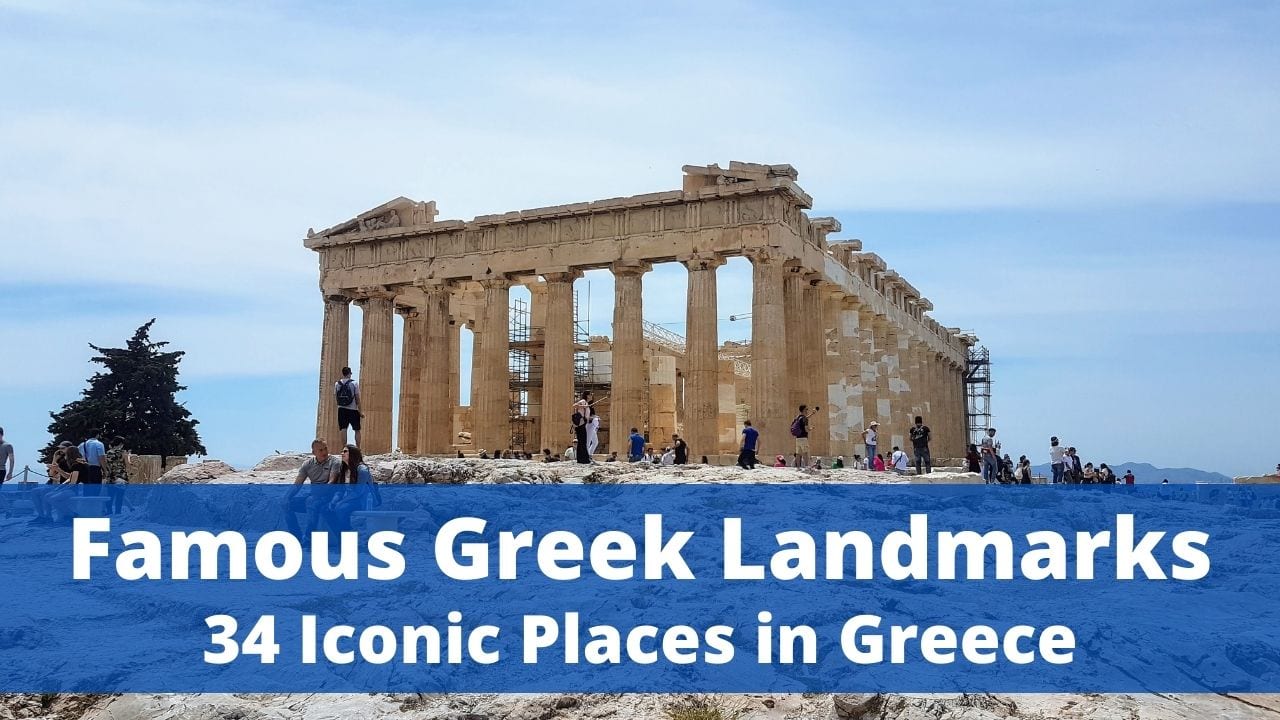
What are the most famous places in Greece? Which Greek landmarks are the most well known?
Greek Landmarks
Greece is a country overflowing with history, culture and natural beauty. It's no surprise then that some of the most iconic landmarks in the world are in Greece!
Here, we'll show you all about the famous Greek monuments, historic sites, and areas of outstanding natural beauty that may just inspire you to take your next vacation in Greece!
Famous Landmarks of Greece
You can either read through this guide from top to bottom, or jump through to a landmark that catches your attention using the menu below.
[one-half-first]
- The Acropolis and Parthenon in Athens
- Hills of Athens
- Tomb of the Unknown Soldier Athens
- Temple of Olympian Zeus in Athens
- White and blue buildings of the Cyclades
- The caldera in Santorini
- Oia sunset in Santorini
- Kleftiko beach in Milos island
- Ancient Delos and the Naxian Lions
- Palace of Knossos in Crete
- Elafonisi beach in Crete
- Spinalonga island in Crete
- Samaria Gorge in Crete
- Navagio beach in Zakynthos
- Myrtos beach and Melissani Cave in Kefalonia
- Medieval Castle in Old Rhodes Town
- Ancient site of Delphi
[/one-half-first]
[one-half]
- Statue of Leonidas at Thermopylae
- Corinth Canal
- Lions Gate of Ancient Mycenae
- Town of Nafplio
- Theatre of Ancient Epidaurus
- Venetian castles in the Peloponnese
- Monemvasia
- Ancient Olympia
- Rio – Antirrio bridge
- White Tower in Thessaloniki
- Promenade in Thessaloniki
- Mt Athos monasteries
- Royal Tombs at Vergina
- Mount Olympus
- Meteora and Monasteries
- Vikos Gorge
- Famous Street Art in Greece
[/one-half]
1. The Acropolis and Parthenon in Athens
The Acropolis in Athens is the most instantly recognizable landmark in Greece, and a UNESCO Heritage Site.
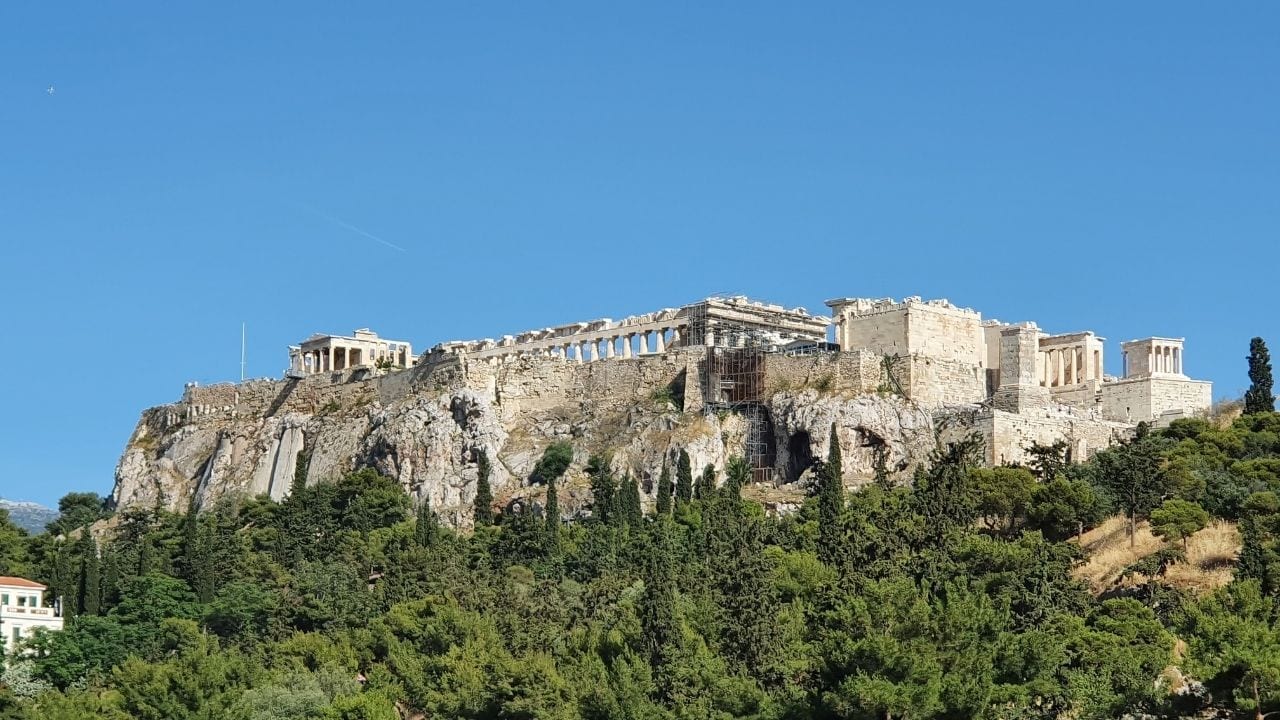
About the Acropolis and Parthenon: It's actually a citadel, often referred to as “the holy rock”. Within this fortified Acropolis complex, visitors can see several monuments and buildings dating back to the peak of Ancient Athens.
Τhe most famous temple in the Acropolis of Athens is the Parthenon, dedicated to the goddess Athena. It was built between 447 and 438 BC and is made entirely out of white marble which was brought from the nearby Penteli mountain.
Facing the Parthenon in the Acropolis, visitors can see the Erechtheion. This is another superb temple, dedicated to both Athena and Poseidon. Its construction was completed in 406 BC and its most famous feature is the series of six female statues, the Caryatids.
The statues that you can see in the Erechtheion today are replicas that were installed in 1979. Five of the original Caryatids have been restored and can be seen in the Acropolis museum. The sixth statue is in the British Museum.
Other noteworthy constructions inside the Acropolis include the Temple of Athena Nike, and the massive Propylaia Gate.
Find out more about the Acropolis and other landmarks of Athens.
2. Hills of Athens
Athens is not exactly what you’d call a flat city! Apart from the Acropolis citadel, there are many slopes and hills all around the city.
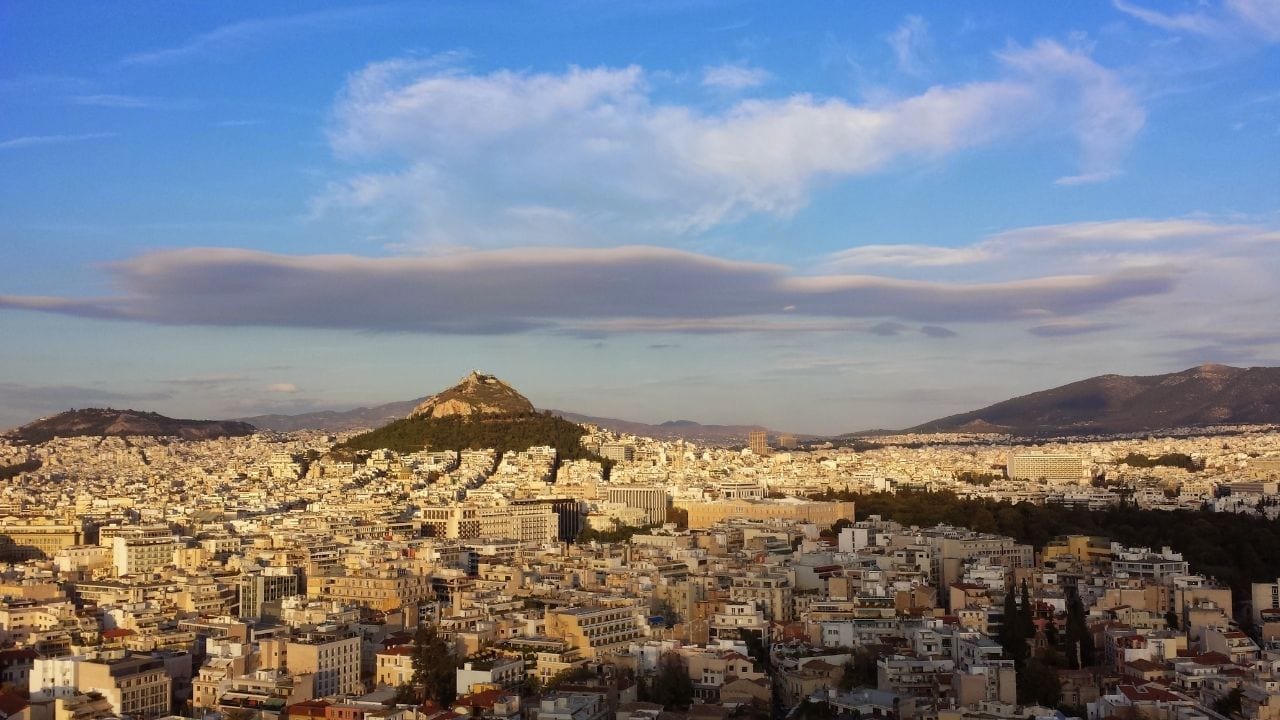
About the Hills of Athens: Areopagus Hill is one of the most popular hills in Athens for visitors, as it’s located just opposite the Acropolis. This is where the Supreme Court’s sessions took place in ancient times. It is also where Apostle Paul delivered a sermon in 51 AD.
Today, you can climb up the stairs of Areopagus in Athens, sit on the rocks, and enjoy one of the best views of the Acropolis.
On the other side of Areopagitou Street, you can see Muses Hill, also known as Filopappou Hill. This is a much appreciated green area in Athens for tourists as well as locals.
At the highest point of the hill, you will find a large mausoleum built in the 2nd century AD. The monument is dedicated to Filopappos, a Roman aristocrat who became an honorary Athenian citizen.
Adjacent to Muses Hill, you will also find Pnyka / Pnyx hill and Nymphs hill. This whole area is lovely for a stroll, and you can get great views of the Acropolis and the city of Athens. You can also visit the National Observatory, located on Nymphs Hill.
Another famous hill in Athens is Lycabettus, known in Greek as Likavittos. At 277 metres, it’s one of the highest points in the city of Athens.
You can walk up on foot, take the cable car from Aristippou street in Kolonaki area, or just take a taxi. Watching the sunset from Agios Georgios church on the top of the hill is a popular activity for visitors.
Related: Why is Athens famous?
3. The Tomb of the Unknown Soldier and Changing of the Guards in Athens
Right on Syntagma square in Athens, and in front of the House of Parliament, lies the Tomb of the Unknown Soldier. This is a cenotaph (an empty tomb) built in 1929-30 as a symbol of appreciation for all the soldiers who died defending Greece.
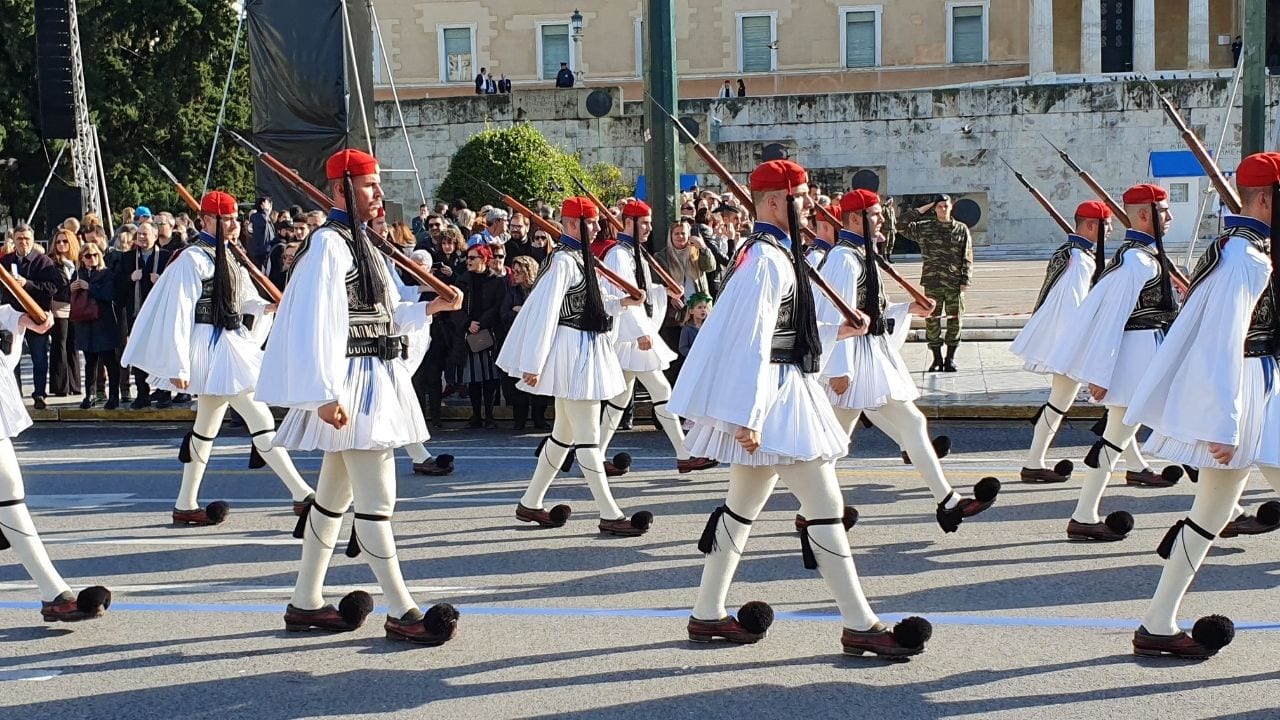
About the Tomb of the Unknown Soldier in Athens: In front of the Tomb of the Unknown Soldier, you will see the Presidential Guards, known in Greek as the Evzones. These men have been carefully selected, based on certain criteria, and have gone through rigorous training.
The Guards stand still in front of the Tomb, in order to protect it and pay their respects to their ancestors. Every hour, on the hour, there is the famous change of the guards, which is a popular attraction for visitors.
On Sundays, at 11 am, there is a ceremonial Changing of the Guards in Athens. This is essentially a big parade, where all the Evzones are participating.
When you visit the Tomb of the Unknown Soldier, follow the guidelines provided by the men in uniforms. You can take photos with the Evzones if you want, but make sure to maintain a distance and be respectful.
4. The Temple of Olympian Zeus in Athens
This huge temple is the biggest temple that was constructed in Greece during Hellenistic and Roman times. Its construction began around the 6th century BC, but it wasn’t completed until the 2nd century AD, by the Roman emperor Hadrian.

About the Temple of Olympian Zeus: The temple is dedicated to Zeus, the King of Gods, and it once consisted of 104 columns. In later centuries, most of them were either destroyed or re-used for the construction of Byzantine temples and other buildings. A gold-and-ivory statue of Zeus was originally constructed in the site.
Today, you can still see sixteen of the original columns, one of which is on the ground. The size of the columns is really impressive!
There are also the remains of other monuments and ancient Greek temples, like the temple of Apollo Delphinios and a small temple dedicated to Kronos and Rhea. Parts of the gates of the Themistoclean Wall, a large wall built around central Athens in ancient times, are also visible.
Just outside the temple of Zeus, you can also see the Arch of Hadrian, another of the iconic landmarks in Athens. Hadrian's Gate is a monument built by the Athenians in 131-132 AD, to honour the Roman emperor Hadrian.
5. The white and blue buildings of the Cyclades islands
The white-washed churches with the blue domes are instantly recognizable as one of Greece’s famous landmarks. This is a prominent feature in the Cyclades islands of Greece, like Mykonos, Santorini and Paros. You’d think that the Cycladic houses are painted these colours after the colours of the Greek flag, but it’s a little more than that!
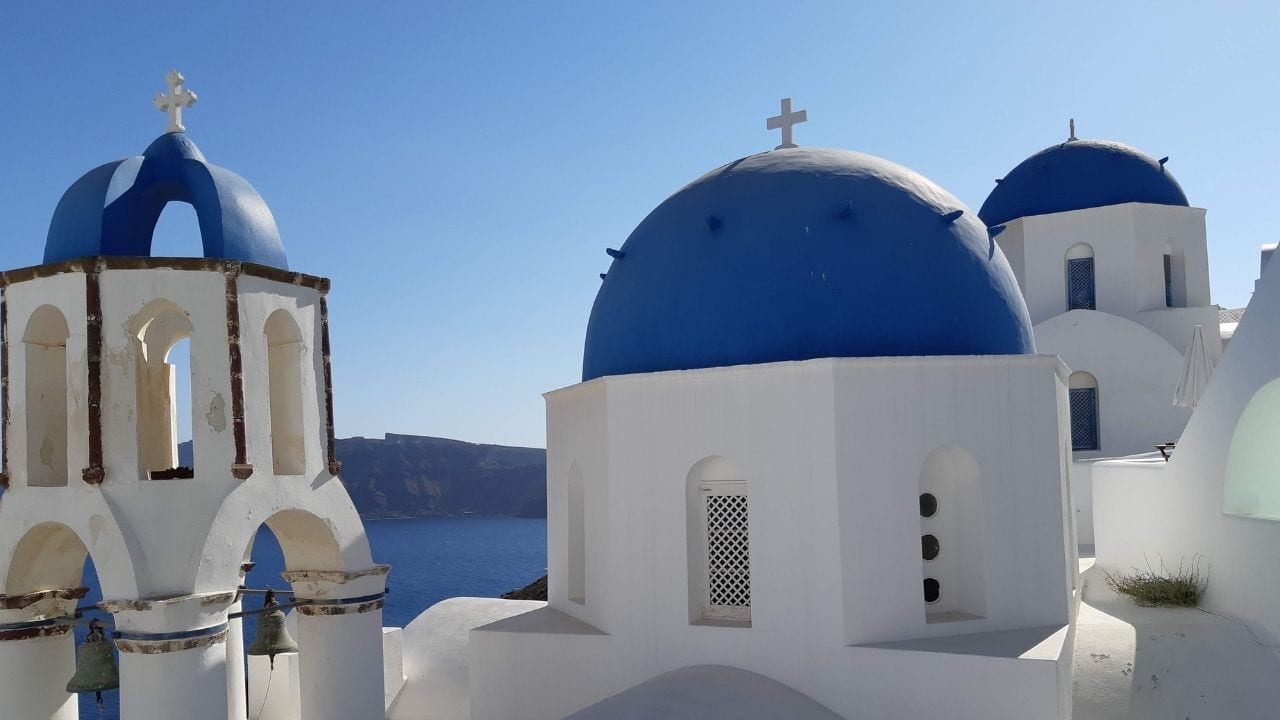
About the blue and white buildings of Greece: Originally, the houses were painted white in order to prevent the plague from spreading out. People treated the walls and streets with a white substance called limestone, to disinfect surfaces. This inexpensive material is still in use, though nowadays modern paints are also applied.
As for the blue? In fact, you can see several bright colours on the Cycladic islands, including red, green, yellow and golden. Blue is probably the most common, as it matches the blue sky!
You can read more about the Cycladic architecture here.
6. The caldera in Santorini
If you have only heard of one Greek island, chances are that you’ve heard of Santorini. The small Cycladic island is famous for its active volcano, to which it owes its unique shape.
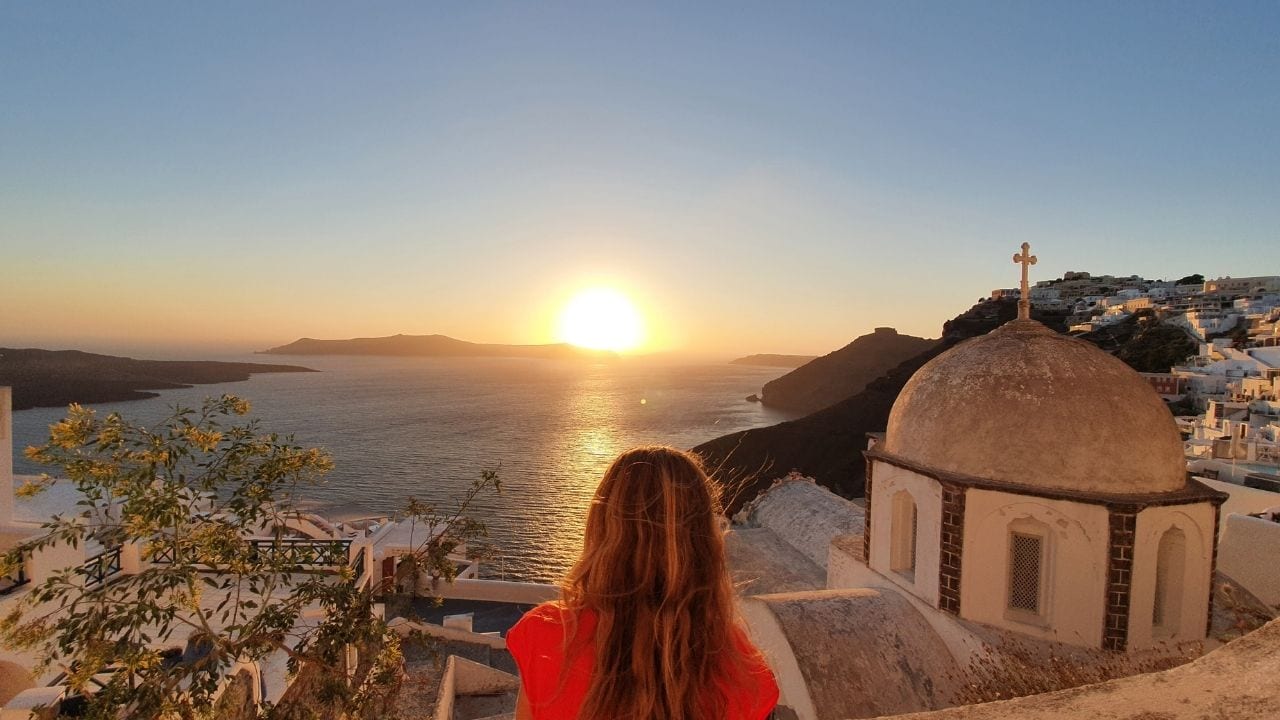
About the Santorini Caldera: If you look at Santorini on the map, you will see that it looks like a croissant. To the west of Santorini, you will see a handful of smaller islands, that were created after a volcano eruption in 1,613 BC. The explosion destroyed the ancient settlements on Santorini. Their remains can be seen at the archaeological site of Ancient Akrotiri.
The archipelago is known as the caldera in Santorini. One of the tiny islands, Thirasia, is inhabited. There are also Palea and Nea Kameni, two deserted volcanic islands that you can visit on a day trip from Santorini. You can then see the otherworldly landscapes and the volcano which is still active!
Visitors often prefer to stay at hotels with a view to the caldera. There are many west-facing towns where you can stay – Fira, Firostefani, Imerovigli and Oia. Fira is the main town, and it’s just about in the middle of the western coast. Oia is at the northwesternmost side of the island, about 10 kms (6.2 miles) from Fira.
The whole western side of the island is great for caldera views. As it’s facing west, it’s great to catch a sunset from.
7. The famous Oia sunset in Santorini
If you’ve heard of just one sunset in Greece, chances are you’ve heard of the famous sunset in Oia, Santorini!
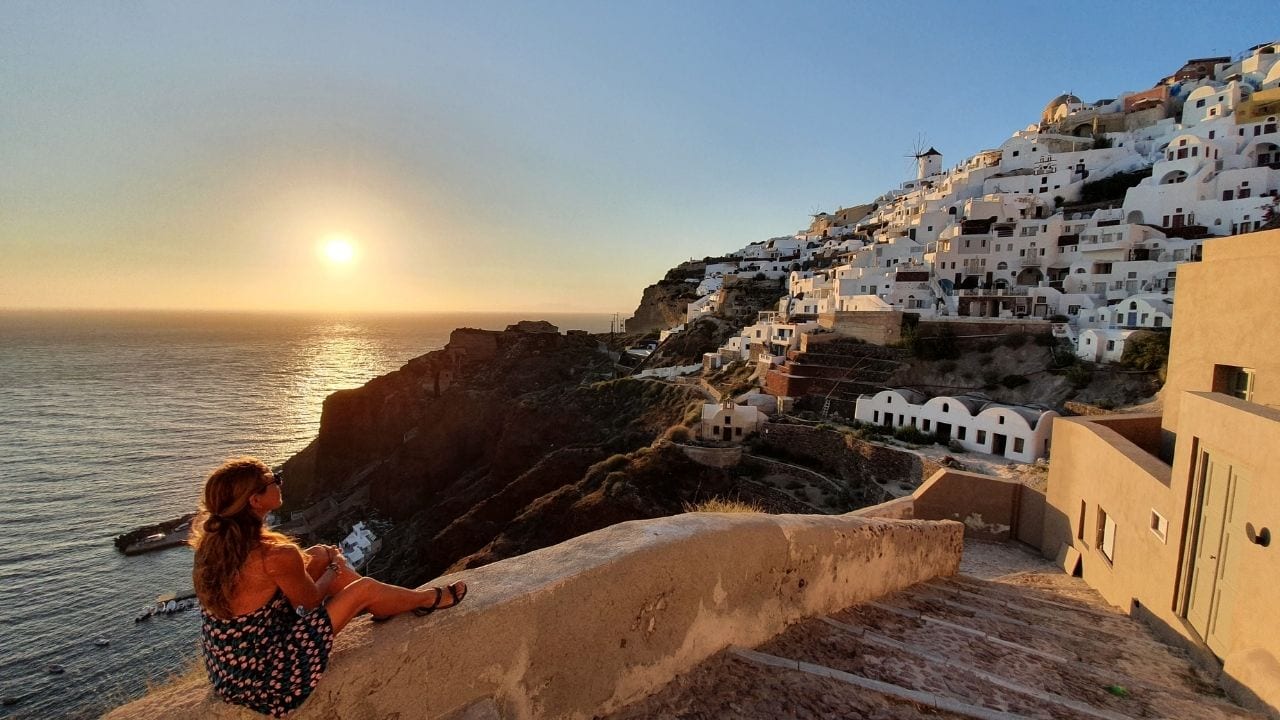
About Oia Town and the Sunset: The small town of Oia built right at the end of a cliff in Santorini is one of the most photographed spots in Greece. Its popularity has grown over the years, and visitors come from all over the world to see the unique sunset.
Even though Oia has grown beyond proportion in the last couple of decades, it’s a picturesque Cycladic town. There are many hotels, restaurants and tourist shops, but the atmosphere is still quaint, especially if this is your first visit to Greece. With that said, don’t expect to have the Santorini sunset to yourself – like I said, Oia is world-famous!
You can get to Oia by bus, taxi or your own vehicle. If you have your own vehicle, note that parking can be a struggle, especially in peak season.
I absolutely loved hiking to Oia from Fira and timed it to arrive at sunset. The views are just fantastic, and you will see a completely different side of the island. This was one of the best hikes I’ve done in Greece, and I will definitely do it again when I return to Santorini.
Tip – while many people choose to stay in Oia when visiting Santorini, I wouldn’t stay there myself. If sunset views were a must, I would prefer to stay in Firostefani or Imerovigli, as they are quieter. Alternatively, if I wanted some relaxed beach time, I’d prefer to stay at Kamari or perhaps Perissa, on the east coast of Santorini.
8. Kleftiko beach in Milos island
Kleftiko beach in Milos island is really special. The iconic rocks jutting out of the sea have been featuring in more and more guides to Greece.
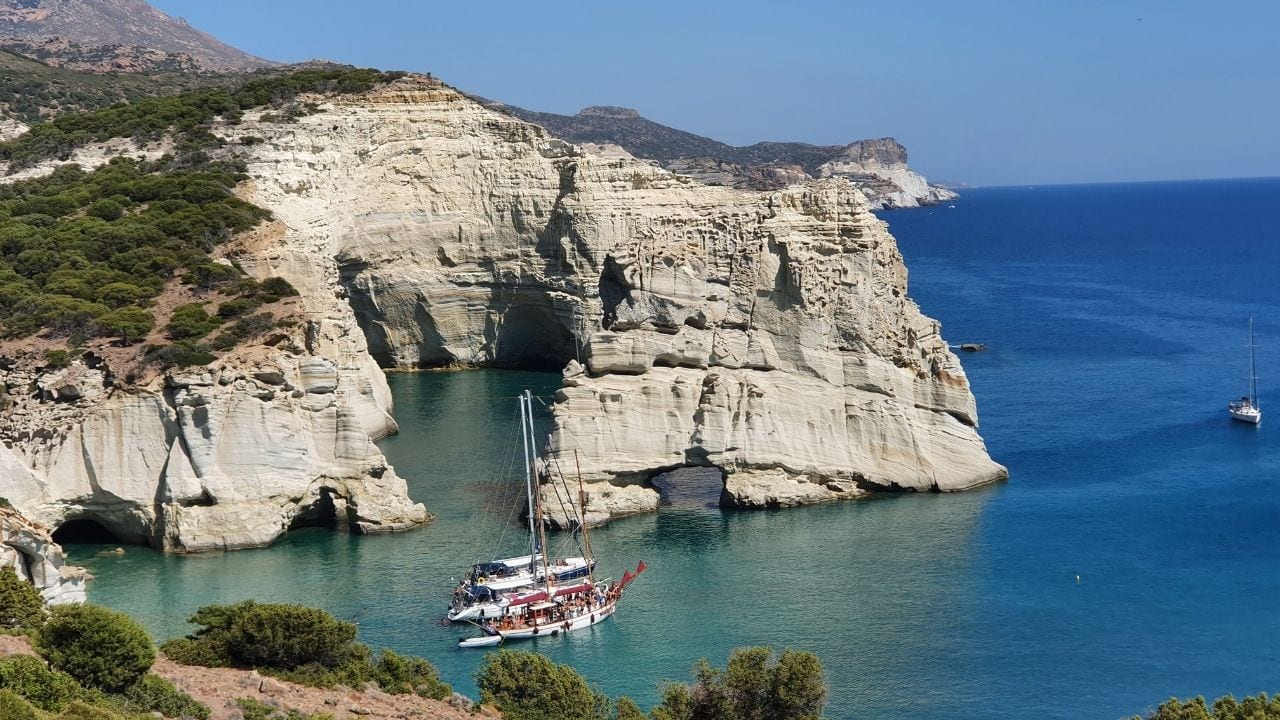
About Kleftiko beach: Kleftiko is a large bay on the southwest side of the Greek island of Milos. There are rugged, tall rocks everywhere, and the landscape is wild and untouched. Snorkeling here is quite an experience when the sea is calm, as the rock formations and caves are just stunning.
Most visitors take a sailing tour to Kleftiko. There are plenty of options to choose from, lasting from a few hours to a whole day. I really enjoyed a full-day Kleftiko trip, where we also visited many other beaches in Milos.
It’s also possible to hike to Kleftiko bay. You will first need to drive to the beginning of the path, which involves a long dirt road. You will then to hike for 40-50 minutes on a path which is a little steep at times.
While this activity not for everyone, the views of Kleftiko from above will definitely reward you for all the hard work!
9. Ancient Delos and the Naxian Lions
Greece has dozens of archaeological sites on both the mainland and the islands. One of the most special is the island of Delos, which is designated as the archaeological area of Ancient Delos, with its most symbolic feature the Naxian Lions.
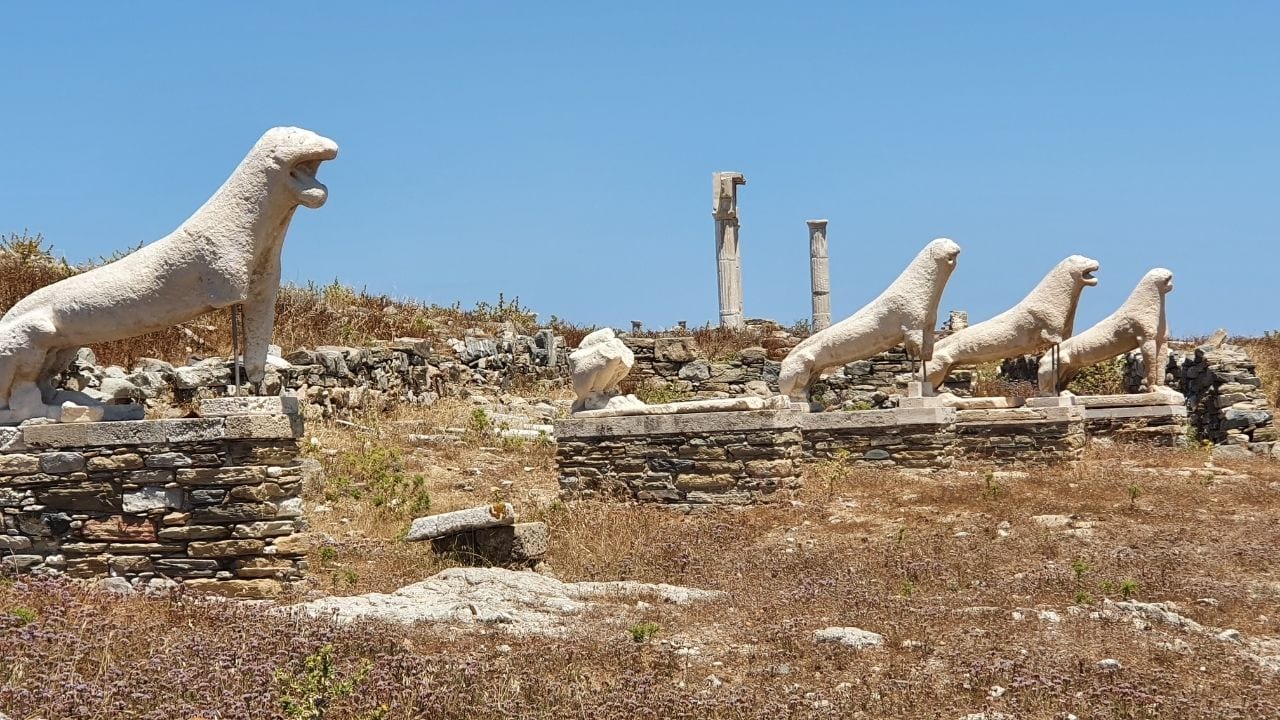
About Delos and the Lions: The small island of Delos is located right in the middle of the Cyclades group of islands. In fact, the Cyclades took their name as they are forming a circle (cycle) around it.
According to Greek mythology, Delos island was the birthplace of the twin gods Apollo and Artemis. As such, it was one of the most famous ancient Greek places and religious centres. Pilgrims travelled from all around the Mediterranean and beyond to visit the sanctuaries of the gods.
During this period, several temples and other public buildings were constructed. Perhaps the most iconic Greek monuments in Delos are the guardian Lions. They were dedicated to god Apollo by the Naxians in the 6th century BC, and were placed in a row leading to the Sanctuary. Their purpose was to inspire awe to the pilgrims.
It is estimated that there were 16 lions originally, but not all of them have survived. Today, you can see their remains in the Archaeological Museum of Delos, where they have been placed for protection from the wind and salt water. You can see replicas where the famous Naxian lions once stood.
During the Roman times, favourable tax laws were introduced in Delos. Many aristocrats, merchants and other professionals of the times moved here. The small island soon became the centre of trade in the whole ancient world. Many of the ruins that you can see today, like the incredible mansions and mosaic floors, date from that era.
In my experience, Ancient Delos is one of the most fascinating ancient sites in Greece. It’s totally worth taking a day trip from Mykonos to Delos to visit this remarkable place.
10. The Palace of Knossos in Crete
Another famous archaeological site in Greece is the Palace of Knossos in Crete. It is located a few kilometres out of Heraklion, the largest city in Crete, in an area full of olive trees and vineyards.

About Knossos Palace: The Palace of Knossos was the heart of the Minoan civilization, which flourished from about 3,000 BC to 1,100 BC. The site had been continuously inhabited since about 7,000 BC and reached its peak during the Minoan period.
Knossos Palace was a series of buildings constructed around a vast courtyard. The living spaces of the royalty were luxurious, decorated with beautiful frescoes and incredible mosaics. Toilets, bathrooms and a drainage system were in place.
Public buildings, cult spaces and craftsmen’s workshops were interspersed in the area. There were also several storage rooms, where crops, olive oil and wine were stored.
When you visit the site, you will wander around the ancient ruins, some of which have partially been restored. The distinctive red and blue colours used in the palace are among the most famous historical landmarks in Greece.
11. Elafonisi beach in Crete
Not many beaches in Greece are as iconic as Elafonisi beach in Crete. Repeatedly voted as one of the best beaches in the world, Elafonisi is famous because of its crystal-clear waters and distinctive pink sand.

About Elafonisi Beach: In reality, Elafonisi is not only a beach, but also a small, uninhabited islet, which is connected to the mainland through a narrow strip of land. The whole area is a protected Natura 2000 area, which means that there are measures in place to protect the natural habitat.
Walking around the island, you will see several types of flowers and plants, and maybe lizards and other animals. Sea turtles and seals have occasionally been seen in the area.
You can get to Elafonisi in your own vehicle, an organised day tour from Chania or a bus. Driving time from Chania is roughly 1.5 – 2 hours. Alternatively, you can take a boat trip from certain towns on the south of Crete, such as Palaiochora.
Another idea is to spend the night near the beach, and get there early in the morning, before tourist groups arrive. Having Elafonisi beach to yourself is an incredible experience!
12. Spinalonga island in Crete
Few of the famous historical landmarks in Greece have a recent history as sad as Spinalonga. The small island located to the north-east side of Crete is one of the most popular places to visit on a day trip from Heraklion.
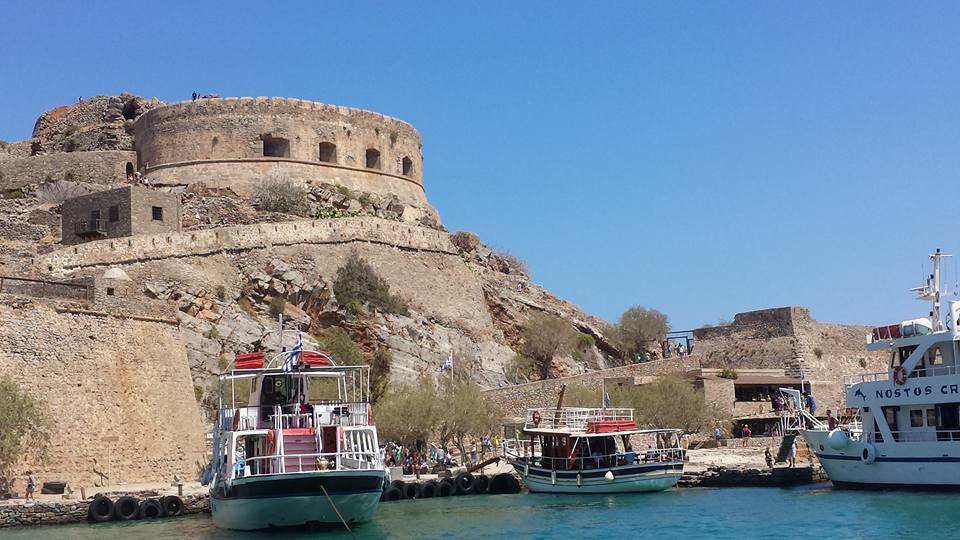
About Spinalonga in Crete: After several centuries during which it was abandoned, Spinalonga was conquered by the Venetians in the 15th century. In order to protect the island from the Ottoman Empire, they built a large fortress, which still stands on the island. Regardless, the Ottomans eventually took over Spinalonga, where they remained until 1898.
In 1903, it was decided that Spinalonga would become a leper colony. Parts of the Venetian walls were destroyed to accommodate a newly established leprosy hospital, which was built on top of the ottoman settlements.
In the next five decades, people with Hansen’s disease from all around Greece were transferred here and were not allowed to leave the island. Spinalonga largely became synonymous with exile and social exclusion.
Eventually, treatment was found for leprosy, and the colony was abandoned in 1957. Spinalonga was declared a historical site in 1970. In the past couple of decades, its popularity has increased, partly due a famous TV series, based on a book called “The Island”, by Victoria Hislop.
You can watch this short video with rare Spinalonga footage from the 1930s – please note that you may find it disturbing.
13. Samaria Gorge in Crete
Greece may be famous for its beaches, but there is so much more to this beautiful country. Not all people realize that mainland Greece and some island are actually very mountainous, with an abundance or rivers, lakes and gorges.

About the Samaria Gorge: One of the most famous natural landmarks in Greece is the Samaria gorge in Crete, located in the region of Chania. It spans an incredible 16 kilometres from Xyloskalo, the north entrance, to Agia Roumeli on the south coast of Crete.
The gorge is an important natural reserve. It is home to several types of pine and cypress trees, as well as endemic animals such as the Cretan wild goat.
Despite its length, crossing the Samaria gorge is a popular activity among tourists, who can visit between April and October. While it’s possible to plan your visit independently, it’s probably easier to take an organized tour, as all your transportation will be taken care of.
14. Navagio beach in Zakynthos
Even if you have never been to Greece, chances are that you have seen photos of the famous Navagio beach in Zakynthos island. The abandoned boat on the powder-white sand surrounded by turquoise waters is a very characteristic image of the Ionian islands.
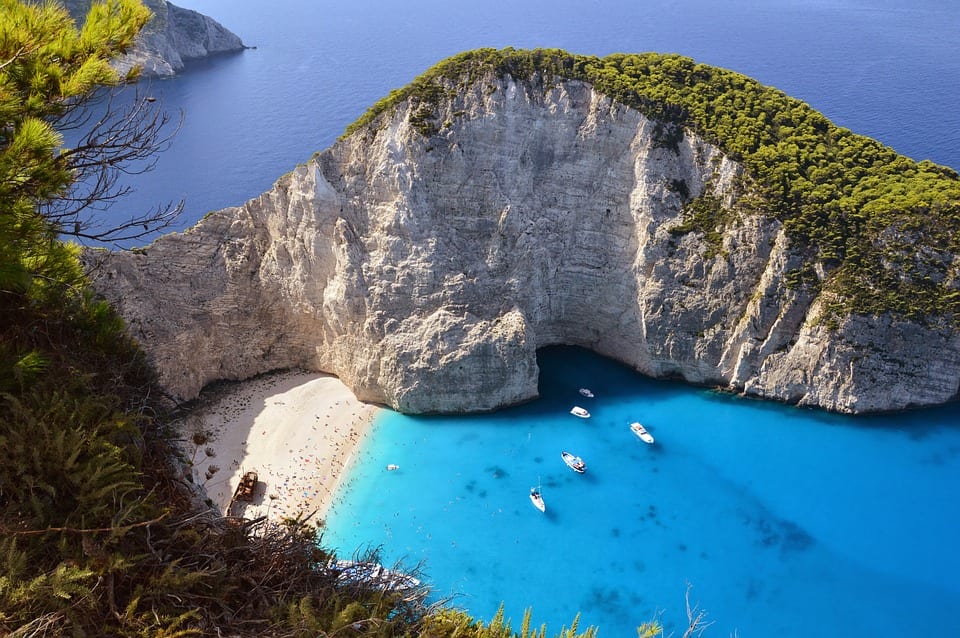
About Navagio Beach: This landmark beach in Zakynthos (Zante) is often referred to as “Shipwreck beach”, which is what the word Navagio means in Greek. The 48-metre long boat crashed on the shoreline due to a mechanical failure in 1980.
Fun fact – originally, the residents of the pretty island were afraid that the shipwreck will put tourists off visiting the island. As it turned out, Navagio beach has become one of the most famous Greek attractions, and thousands of tourists come here on an annual basis. In fact, no one uses the original name of the beach, Agios Georgios, anymore!
The Shipwreck beach in Zakynthos can only be approached by sea. If you only want to take photos, you can reach the viewing point which overlooks the beach.
Tip – be patient, as there will likely be many more visitors. After all, Navagio is one of the most famous natural landmarks of Greece!
15. Myrtos beach and Melissani Cave in Kefallonia
It would probably be an exaggeration to say that it was the 2001 movie, Captain’s Corelli’s Mandolin, that put Kefalonia on the map, but it definitely helped!

About Myrtos beach and Melissani Cave: Kefalonia is the largest of the Ionian islands that are located to the west of the country, and Greece’s sixth biggest island. In combination with its rich history, this means that there is a lot to do in terms of sightseeing.
The island has many important monuments including the Venetian Asos castle, the Byzantine castle of St George, and several memorials and statues all around the picturesque towns. Moreover, you can see some interesting landmarks, like the De Bosset bridge, that were built in the early 19th century, when the island was occupied by the British.
Kefalonia’s best known attractions, however, are its natural landscapes. Myrtos beach, with the dazzling white sand and sparkling blue waters, is one of the prettiest beaches in Greece.
In addition, Melissani cave attracts visitors from all over the world. It is a unique geological phenomenon combining a cave, an underground lake and a small islet.
16. The Medieval Castle in Old Rhodes Town
The Old Town in Rhodes island is home to an amazing medieval castle, known as the Palace of the Grand Master of the Knights of Rhodes.
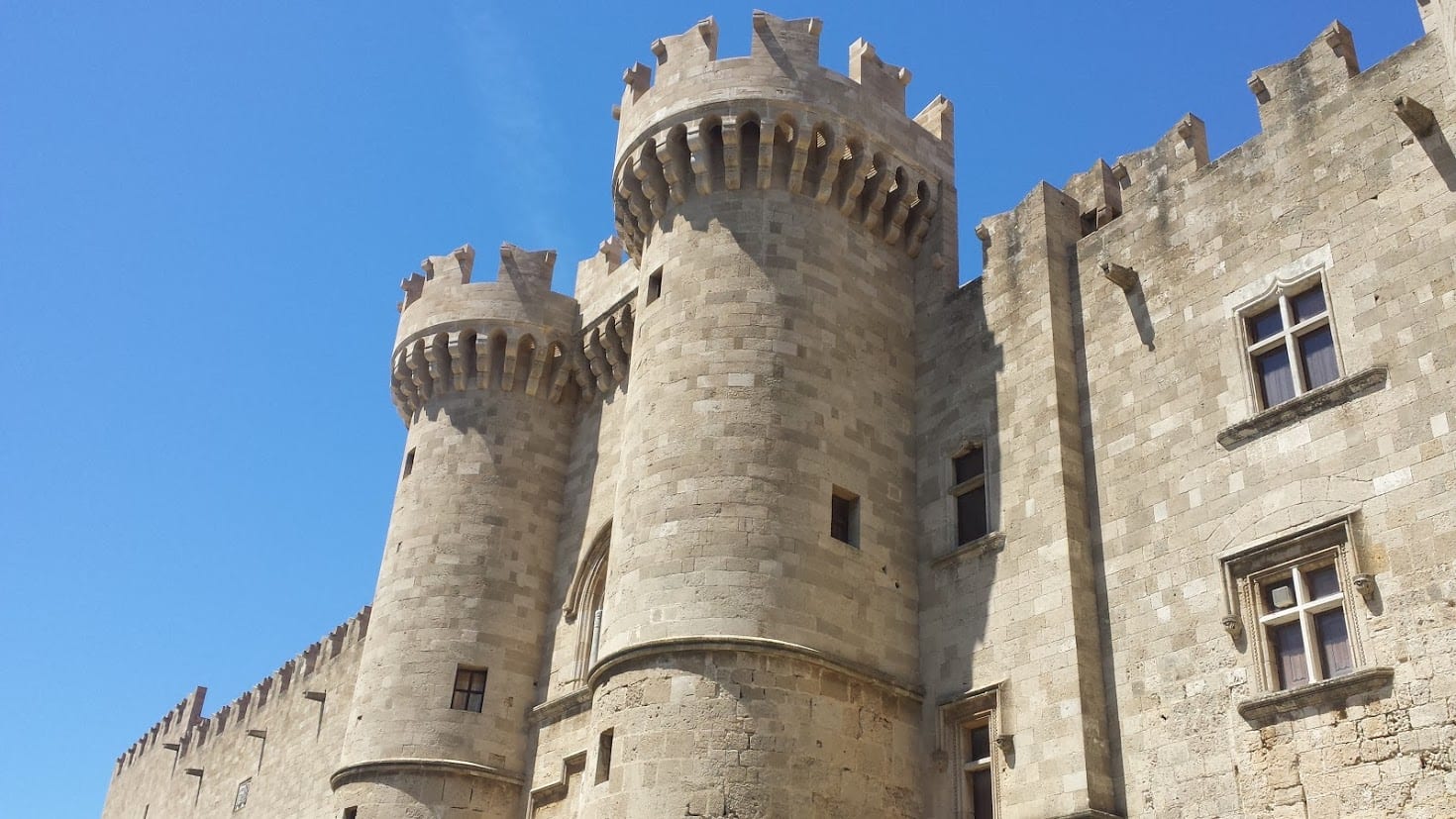
About Rhodes Castle: In 1309, the medieval Christian military order known as Knights Hospitaller conquered Rhodes and the nearby islands. They expanded the existing Byzantine settlement, and built a huge palace, including administrative headquarters. The whole citadel was fortified and surrounded by a massive fortress.
In later centuries, the palace was used by other conquerors, including the Ottomans and the Italians, and was occasionally restored and modified. When Rhodes and the rest of the Dodecanese islands were handed over to Greece in 1948, the palace was turned into a museum.
Only certain rooms of the palace are open to the public today. Visitors can explore the unique furniture and artefacts including sculptures, jewellery, books and weapons, as well as the impressive mosaics and frescoes. In addition, performances and exhibitions are often organized in the spacious halls.
Rhodes castle is the most impressive fortress I’ve seen in Greece, not least because of its size. Apart from the museum itself, walking around the medieval walls is an unforgettable experience.
17. The Ancient site of Delphi
In Ancient Greece, Delphi was considered the centre of the world! Today, Delphi is on of the most important landmarks in Greece.
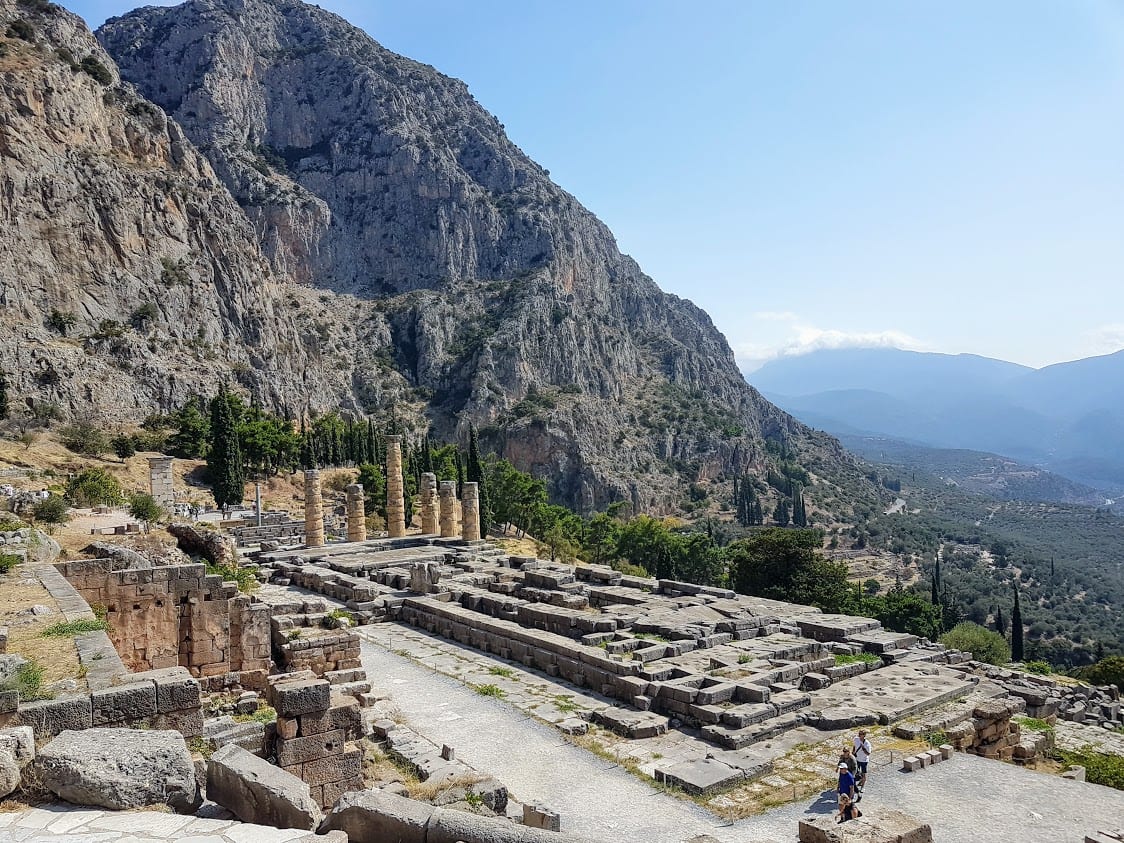
About Delphi in Greece: According to legend, the king of gods, Zeus, released two eagles from Mount Olympus, and let them fly in opposite directions. The place where they eventually met was over Delphi, that Zeus proclaimed to be the navel (omphalos) of the Earth.
Delphi is a massive ancient site at an altitude of a few hundred metres on mount Parnassus, about 3 hours out of Athens. If you want to explore the site properly, you will need at least a couple of hours to walk around. The setting is very impressive, with literally thousands of fir trees.
The most significant ruins that you can see in Delphi include the temple of Apollo, to whom the site was dedicated, the theatre and the ancient stadium. Climbing up to the stadium will reward you with lovely views of the whole site, so I totally recommend it.
There's also the excellent Delphi museum next to the site, which is home to several ancient artefacts, the most famous of which is the bronze Charioteer statue, known in Greek as Iniohos.
Across the street from the main site, you can also visit the temple of Athena Pronaia. Not everyone knows of this smaller temple, and if you are visiting during the off-season you might even be there on your own!
You can visit the Ancient site and museum of Delphi on your own, but an easier option is to go on an organized day trip from Athens to Delphi.
18. The statue of Leonidas at Thermopylae
You will rarely see this statue in a list of famous landmarks in Greece, but it’s actually an important monument. It commemorates the historic battle of Thermopylae between the Ancient Greeks and the Persians.
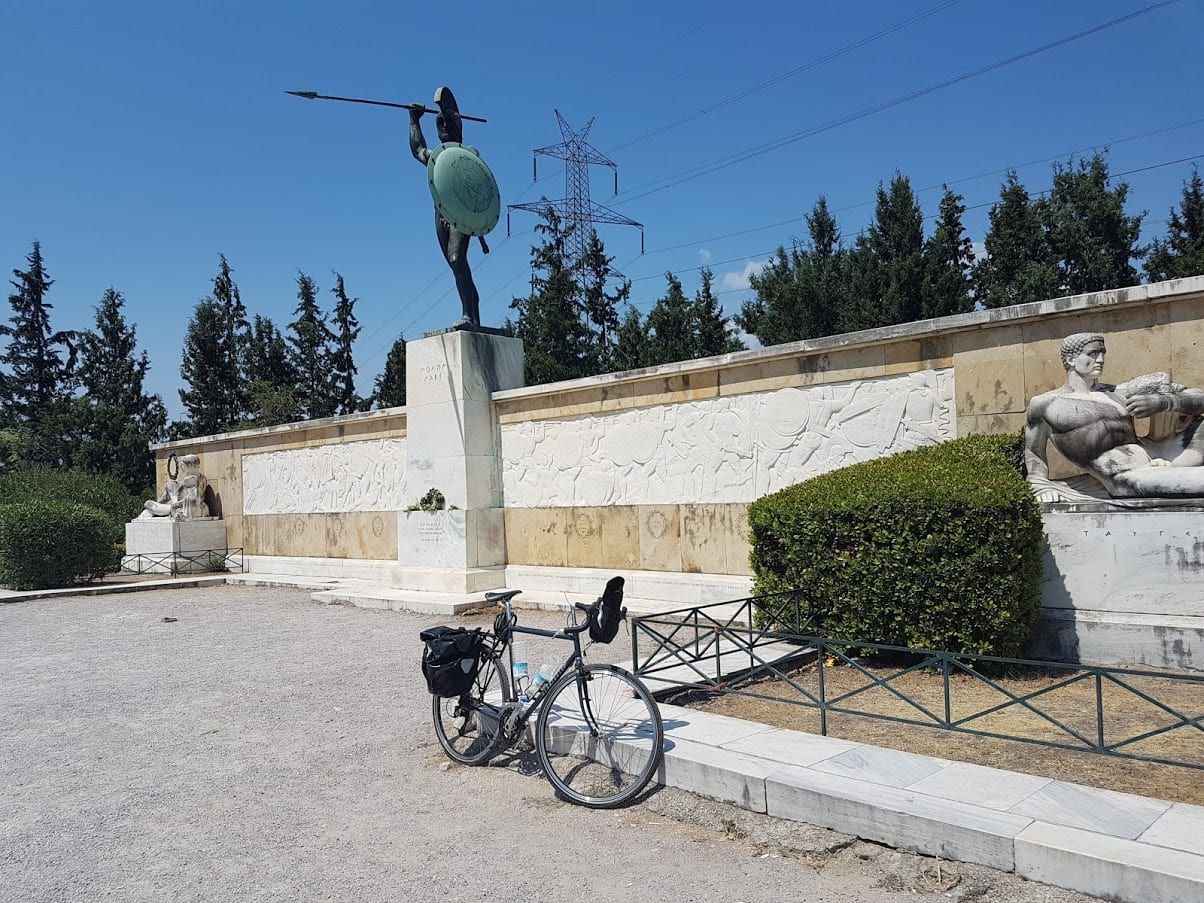
About the Leonidas statue at Thermopylae: In ancient times, there were a number of Greek city-states that occasionally fought between themselves. However, when there was an external danger, they often formed an alliance, to fight against the foreign enemy.
This was the case during the battle of Thermopylae, in 480 BC. A large Persian army arrived in Greece through the strait known today as Dardanelles. Modern historians estimate the size of the Persian army to be between 70 and 300 thousand men.
The army made its way to the south, aiming to cross a narrow passage in the area of Thermopylae. This was the area where a Greek allied army decided to confront them. The Greek army consisted of only seven thousand men, of which 300 were Spartans, led by King Leonidas.
Even though the Greeks were outnumbered and defeated in the battle of Thermopylae, their courage and bravery became a symbol for future generations. The statue of Leonidas was erected in 1955, as a tribute to the brave King of the Spartans. Here’s a short video of the inauguration.
If you decide to include Thermopylae in your itinerary in Greece, you should also visit the nearby Historical Center of Thermopylae, where you can learn more about Leonidas and his 300. After all, few battles in the ancient world have been so inspirational. You will then find out that the movie “300” is not entirely historically accurate!
19. The Corinth Canal
Corinth Canal is one of the most famous Greek landmarks, and rightly so. It is really a miracle of modern engineering, with a length of 6.4 kms and a depth of 90 metres.
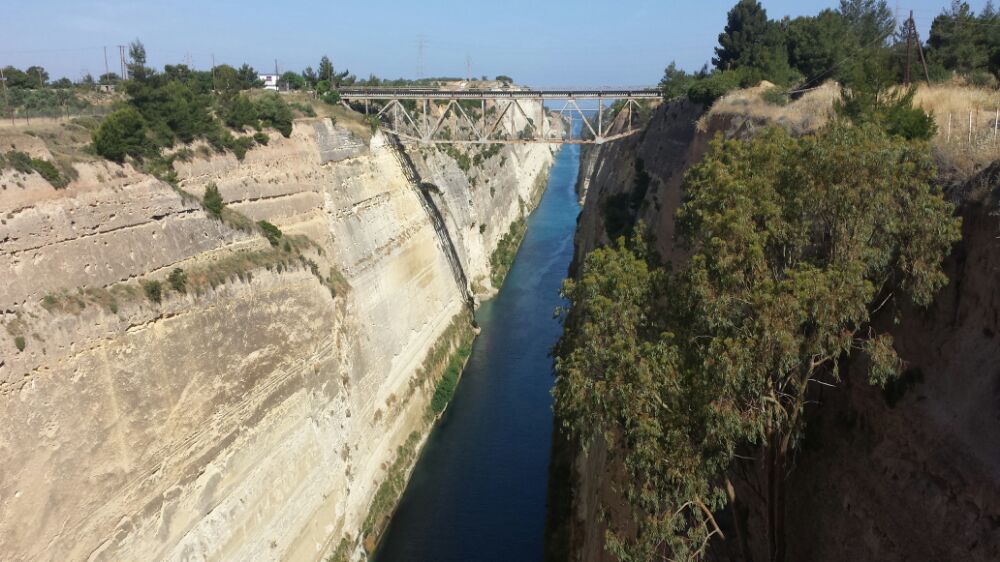
About Corinth Canal: The canal connects the Aegean and the Ionian seas, while separating the Peloponnese from the rest of mainland Greece.
Several attempts to construct a canal had been made in ancient and Roman years, but none were successful. It wasn’t until 1893 when the canal became a reality, after several years of planning and construction works.
As the canal is just under 25 metres wide, only certain types of boats can go through. In 2019, a large cruiseship carrying more than 1,200 passengers sailed through the canal. You can watch the impressive video here, and don’t forget to breathe!
If you are going to the Peloponnese, you should by all means stop for a few minutes at the Corinth Canal. Words don’t it any justice, so you have to see it for yourself. And if you are feeling brave, you could perhaps try some bungee-jumping!
20. The Lions Gate of Ancient Mycenae in the Peloponnese
The Peloponnese, which is the southernmost part of mainland Greece, is very rich in terms of history. One of the most important sites is Ancient Mycenae, which belongs to UNESCO’s list of World Heritage Sites.
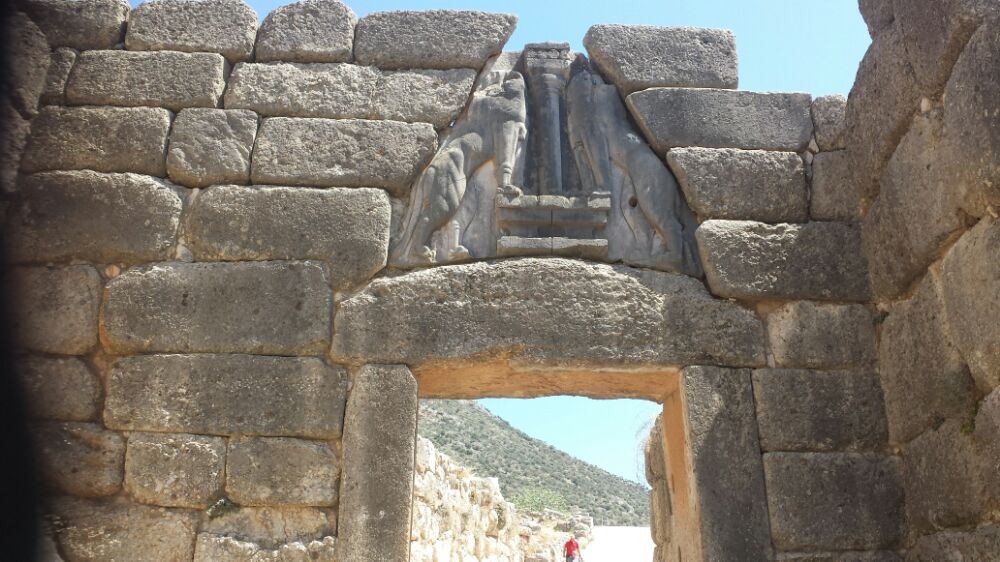
About Mycenae and the Lions gate: The city of Mycenae was the centre of the Mycenaean civilization, which flourished between roughly 1,600 and 1,100 BC towards the end of the Minoan era.
Agamemnon, the son of Atreus, was the legendary King of Mycenae at the time of the Trojan War. In fact, Agamemnon initiated the war when Paris of Troy abducted his brother’s wife, Helen.
The Trojan War has been beautifully recited by Homer in his epic poem Iliad, which is where much of the information about Mycenae comes from. Almost a millennium later, the historian Pausanias travelled extensively around Greece, and wrote about many famous landmarks in ancient Greece, including Mycenae.
Excavations in Ancient Mycenae began in the 1840s. The first part of the site to be discovered was the famous Lion Gate, which was the main entrance to the site. It consists of a large sculpture of two lions standing above the entrance. The descriptions that had been made by Pausanias almost two thousand years ago made it possible to identify the Lion Gate.
Other ancient monuments include the Mycenaean tombs, such as the Treasury of Atreus and the Tomb of Clytemnestra. Visitors should also spend some time in the museum, where you can see many of the artefacts found in the site and find out more about its glorious history.
21. The picturesque town of Nafplio
Just a couple of hours away from Athens, you can visit the quaint town of Nafplio. The small coastal city in the Peloponnese was the first capital of modern Greece, until 1834 when Athens took its place.
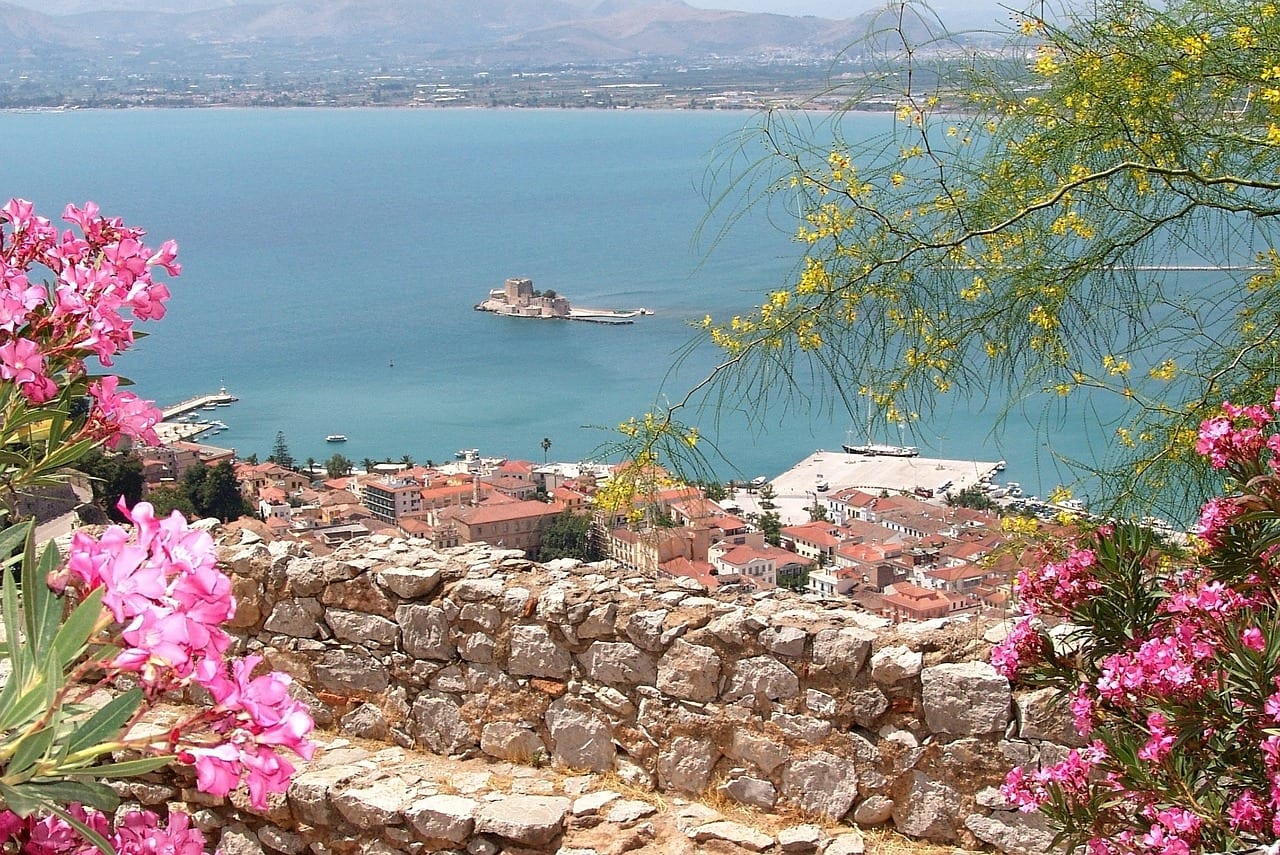
About Nafplio Town: It is no exaggeration to say that Nafplio is one of the prettiest towns in Greece. A combination of neoclassical buildings, the large squares and beautiful seaside promenades make it an attractive year-round destination.
The best-known landmark in Nafplio is Bourtzi castle, built on a little island a short distance from the shore. It was originally constructed by the Venetians in 1473 and was reinforced in 1698, resulting in a well-fortified castle. In the 20th century it was transformed into a hotel, which operated until the late 1960s.
Today, tourists can visit the castle on a boat departing from the small marina. At the moment, the castle is not organized for visits, and you probably won’t be able to enter. It’s best to ask around for the latest information, or just sit by a café at the promenade to enjoy the magnificent sunset!
Apart from Bourtzi, there are many more places to visit in Nafplio, such as Palamidi castle on top of the hill, and several museums. Or you can just take it easy, and just stroll around the pretty streets.
22. The theatre of Ancient Epidaurus
The Ancient Theatre of Epidaurus in the Peloponnese is one of the most famous Greek landmarks, known around the world for its superb acoustics. It was built around 340-330 BC, in honour of the son of Apollo and God of Medicine, Asklepios.
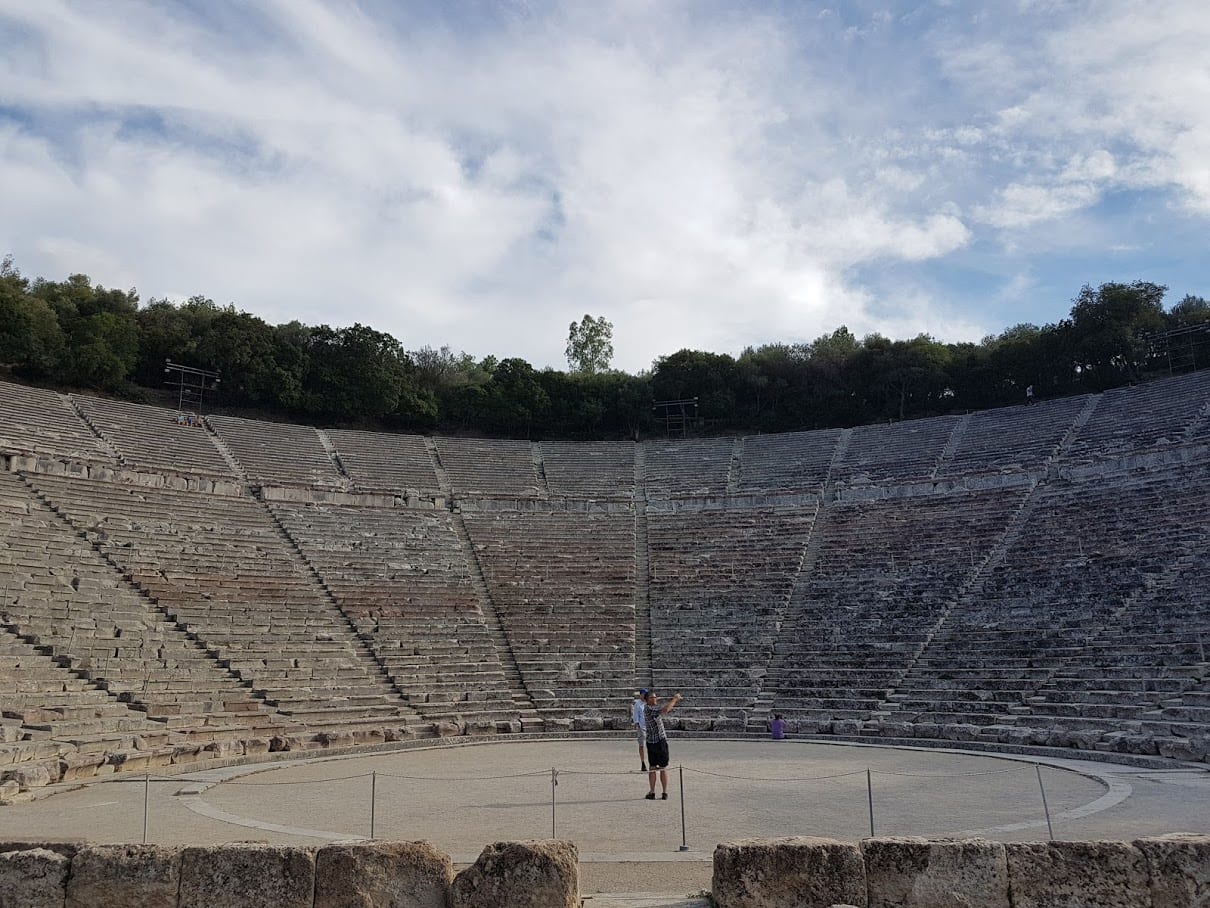
About Epidaurus: In ancient times, the site of Ancient Epidaurus was home to a centre for medical treatment. Patients came from far and wide to be healed by Asklepios. Treatment methods included, among others, diets and some type of hypnotherapy called enkoimisis.
Attending performances in the ancient theatre of Epidaurus was part of the treatment, as it was believed that they could help improve the patients’ health. At its peak, the theatre could accommodate around 14,000 people.
Today, visitors can explore the ancient site during the daytime. In summer, performances and music events are being held in the ancient theatre. If you have the opportunity, you should absolutely attend one, as the setting is really phenomenal.
If you have limited time in Greece, the easiest way to visit the theatre of Epidaurus, Mycenae and Nafplio, is to take an organized guided tour from Athens. This tour will also pass by the Corinth Canal.
23. Frankish and Venetian castles in the Peloponnese
The Peloponnese is home to several Frankish and Venetian castles. I’ve already mentioned the Venetian castles in Nafplio, but there are dozens more.
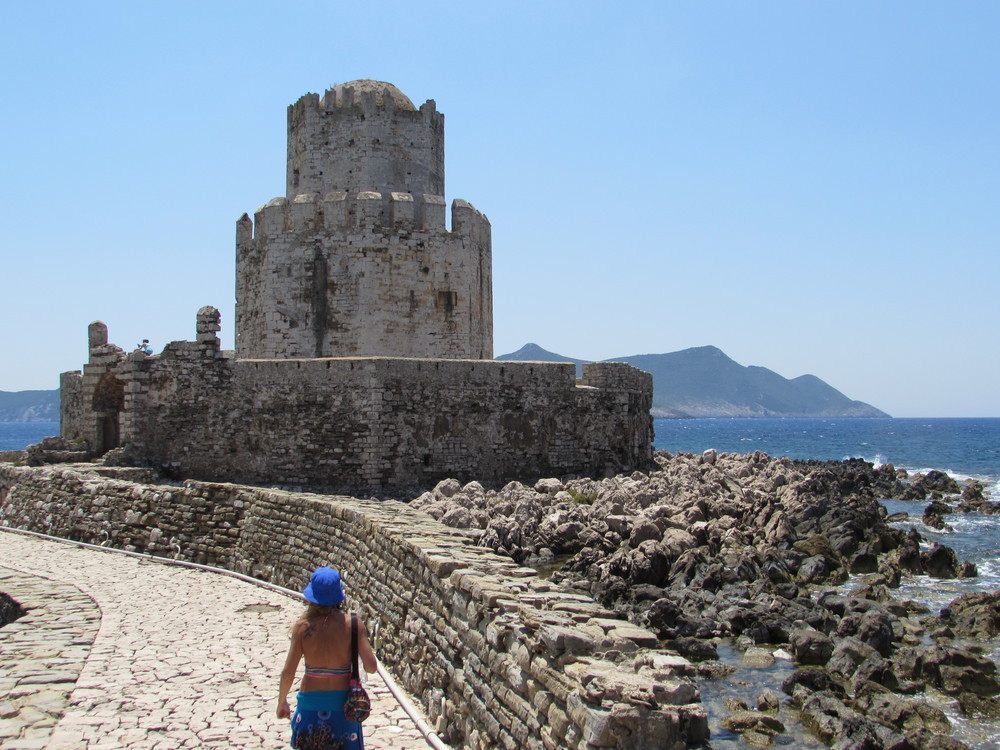
About Castles in the Peloponnese: From a geographical point of view, the Peloponnese was always important, and all outside invaders aimed to conquer this part of Greece. The Byzantines built many temples and castles in the Peloponnese, some of them over the ruins of ancient temples, like the castles in Patras and Kalamata.
The Frankish and the Venetians first arrived in the Peloponnese in the early 13th century. They built new castles, and often reinforced existing ones. Quite often, their castles changed hands, or were later occupied by the Ottomans.
Two of the most noteworthy Frankish castles in the Peloponnese include Chlemoutsi, near Kyllini, and the huge castle of Mystras, not far from Sparta.
The first Venetian castles in the Peloponnese were those in Methoni and Koroni. Methoni castle is one of the most impressive castles in Greece that I’ve visited. As for Koroni, you will be surprised to discover that people still live here!
In later centuries, the Venetians expanded to other areas of the Peloponnese, such as Pilos, Argos and Nafplio. While Niokastro castle in Pilos was originally built by the Ottomans, the Venetians further expanded and fortified it.
It would take you several days to see all the castles in the Peloponnese. People who only have time for one, often head out to the castle of Monemvasia.
24. The castle in Monemvasia
One of the most popular Greek landmarks in the Peloponnese is Monemvasia. Located on an islet off the south-east coast of the Peloponnese, it is an impressive citadel featuring in many Greece itineraries.
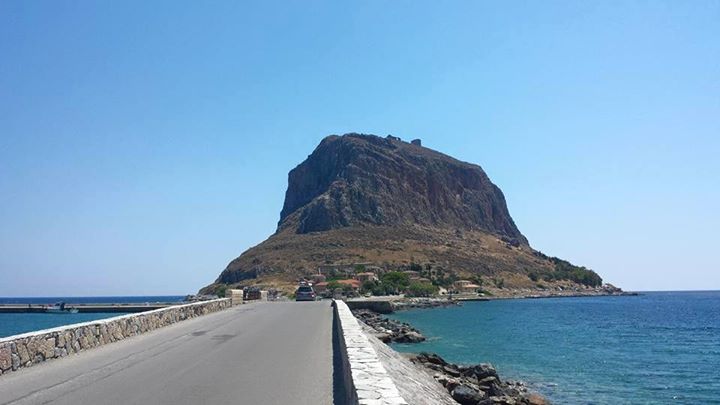
About Monemvasia: Consisting of a huge monolith and castle, Monemvasia is connected to the mainland via a causeway.
The town and original castle of Monemvasia was founded in the 6th century, during the Byzantine era. Due to its important geographical location, its significance increased over the centuries. The Frankish, the Venetians and the Ottomans all conquered the castle at some point in history.
Today, many of the buildings in Monemvasia are still in good condition, all things considered. You can see the remains of the medieval town, including houses, churches, cisterns and storage areas.
The restaurants, cafes and other tourist facilities blend in with the medieval settlement, making Monemvasia one of the famous landmarks in Greece.
25. The stadium in Ancient Olympia
Did you know that the first Olympic Games were held in 776 BC in Ancient Olympia? This unique archaeological site is another UNESCO site and one of the most famous ancient Greek landmarks.
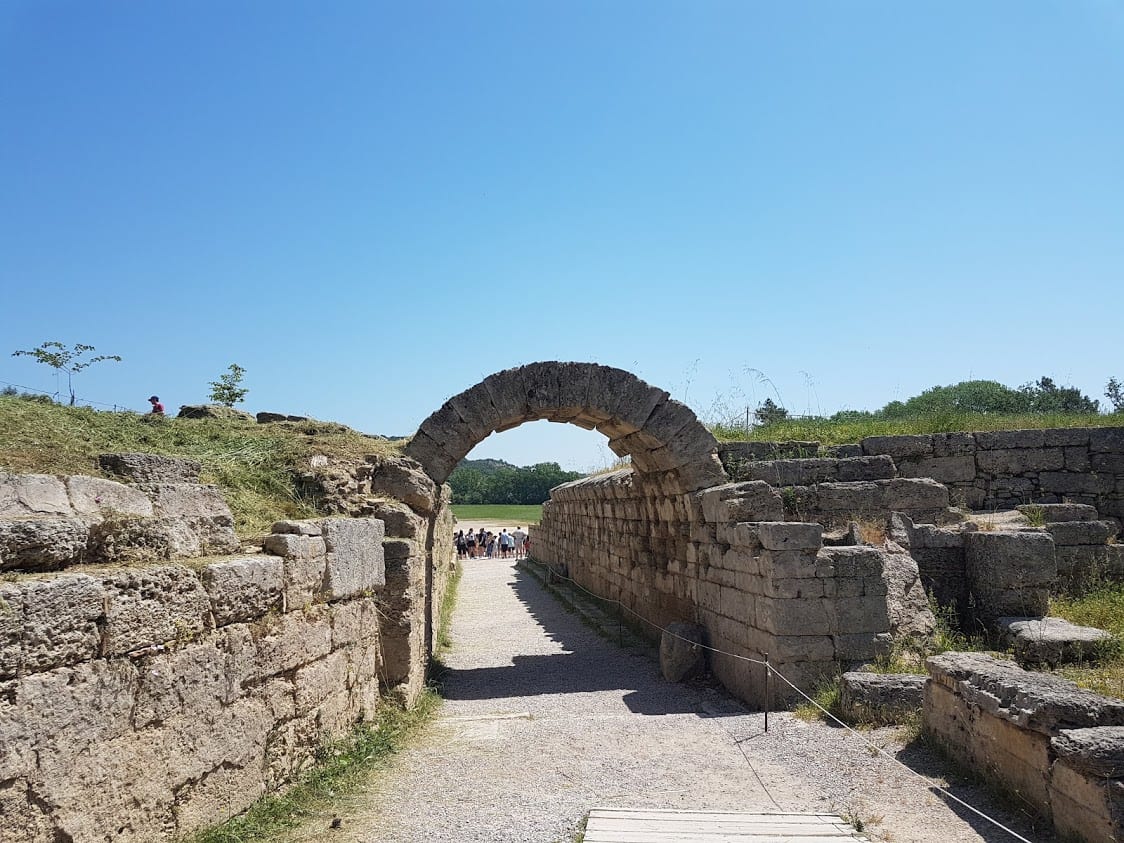
About Ancient Olympia: The Ancient Olympic Games were held in honour of Zeus, the king of the Olympian gods. They originally consisted of races, but more sports were gradually incorporated.
The Games became the most important athletic event of Ancient Greece, and Greek men arrived from far and wide to participate. A massive temple of Zeus, and several buildings used for training, lodging and administrative purposes were constructed.
The large stadium in Olympia could accommodate up to 45,000 people. Unlike other stadiums, the one in Olympia didn’t have seats, and spectators had to sit on the ground.
The Olympics were discontinued in 393 AD, and the cult of Zeus was prohibited. Today, most of the original constructions have been destroyed, but you can see many ruins, including the remains of the large Stadium.
There are also three (!) museums on the site, explaining all you need to know about Olympia and the Olympic Games.
26. Rio – Antirrio bridge
The Rio – Antirrio bridge doesn’t feature often in the lists of the most famous landmarks in Greece. It could be because it’s fairly new – it was completed in 2004.

About the Rio – Antirio bridge: The bridge is located in Western Greece, close to the city of Patras. It connects a town called Rio in the Peloponnese with a town called Antirrio in mainland Greece, close to Nafpaktos.
The type of this fascinating bridge is multi-span and cable-stayed. It is 2,252 meters long, which makes it one of the longest bridges on the planet. Its construction was a challenge, as there were several technical issues to overcome.
The bridge is named after Greece’s prime minister, Charilaos Trikoupis. He was the person who came up with the idea for the bridge’s construction, in 1880.
The toll to cross the bridge is quite steep (13.50 euro for cars), but it can definitely save you time. Alternatively, you can use the old-school boats that still make the Rio – Antirrio crossing, and observe the wonderful bridge from a distance.
27. The White Tower in Thessaloniki
Ask any local about the most important landmark in Thessaloniki, and one answer will invariably crop up: The White Tower. Located right by the coastal promenade, it has been the symbol of the city for many centuries.

About the White Tower of Thessaloniki: The first fortification on the site was built during the Byzantine Era, around the 12th century. When the Ottomans conquered the beautiful city in 1430, they built the 34-metre-tall Tower.
Over the next few centuries, the Ottomans used the Tower not only as a fortress, but also as a Janissaries garrison, and ultimately a prison. Several prisoners were murdered here. As a result, the tower was often referred to as “the Red Tower”, indicating the blood of the victims.
In 1883, following the Sultan’s orders, a Jewish convict painted the tower white, in exchange for his freedom. Thessaloniki was liberated from the Ottomans in 1912, and the “White Tower” became a symbol.
Nowadays, the White Tower is an excellent museum presenting the history of Thessaloniki. You can visit as part of your stroll on the beautiful promenade.
28. The promenade in Thessaloniki
Among Greeks, the coastal promenade in Thessaloniki is the most instantly recognizable seafront in Greece. The 6-km esplanade between the port of Thessaloniki and the Megaron Concert Hall is a beautiful, vibrant walk.

About the Thessaloniki promenade: You can start your walk at the port of Thessaloniki, where you can visit the excellent Photography and Cinema museums. Walking towards the White Tower, you will pass by the impressive Aristotelous Square. On your way, you will find several museums, markets, restaurants and cafes.
Pass the White Tower, and you will notice that the ambiance changes. You will first encounter a massive statue of Alexander the Great. The name of the city is owed to his step-sister, Thessaloniki, who got married to Kassandros, the founder of the city.
The next stretch of the promenade leads to another popular Greek landmark. These are the famous umbrellas by a prominent Greek artist, George Zoggolopoulos. Around this area, there are also green spaces, and bike lanes. You will see buskers, skaters, and many people of all ages enjoying the public space.
In my opinion, this is one of the prettiest urban areas in the whole of Greece, if not Europe! More here on the best things to do in Thessaloniki.
29. Mt Athos monasteries
One of the most mysterious and unique areas in Greece is Holy Mount Athos. This peninsula is located in the region of Chalkidiki, a couple of hours out of Thessaloniki. It is a mountainous and steep area with dense forests.
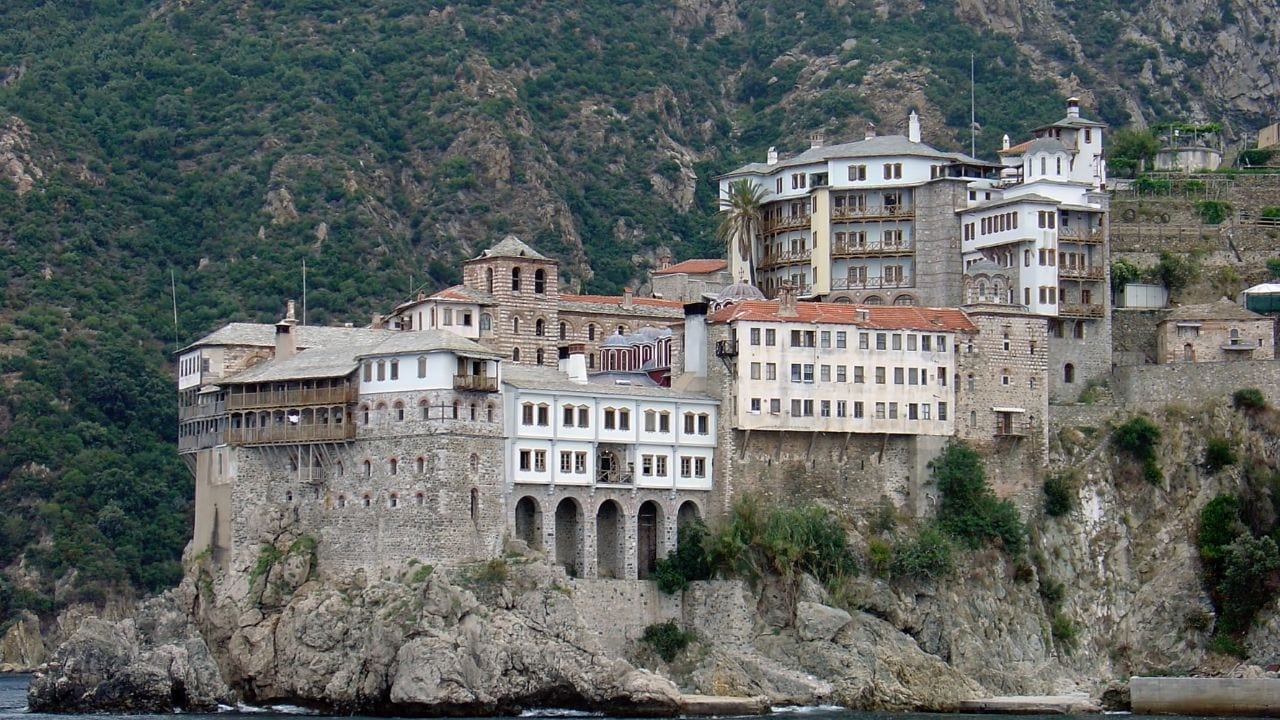
About Mount Athos and Monasteries: This secluded area is home to 20 Orthodox monasteries, of which seventeen are Greek. The remaining three are Russian, Serbian and Bulgarian. Around 2,000 monks are estimated to live in the monasteries.
Mt Athos is an autonomous monastic state, with a special jurisdiction and its own regulations. As such, only males are allowed to enter the area. People planning to visit must secure a special permit well in advance.
As you would expect, Mt Athos is a UNESCO site. Within the stunning monasteries, thousands of old manuscripts, impressive artworks and other religious artefacts are being kept. Men interested in religious history should definitely plan to visit once in their lives.
It is possible to sail around the peninsula on organized trips. These are open to both men and women, and they are an easy way to see the monasteries from a distance.
You can get an idea about life in Mt Athos in this interesting documentary.
30. The Royal Tombs at Vergina
The small town of Vergina in North Greece is best known for the UNESCO site of Ancient Aigai. It was the first capital of the ancient kingdom of Macedonia, and the place where Alexander the Great was enthroned.
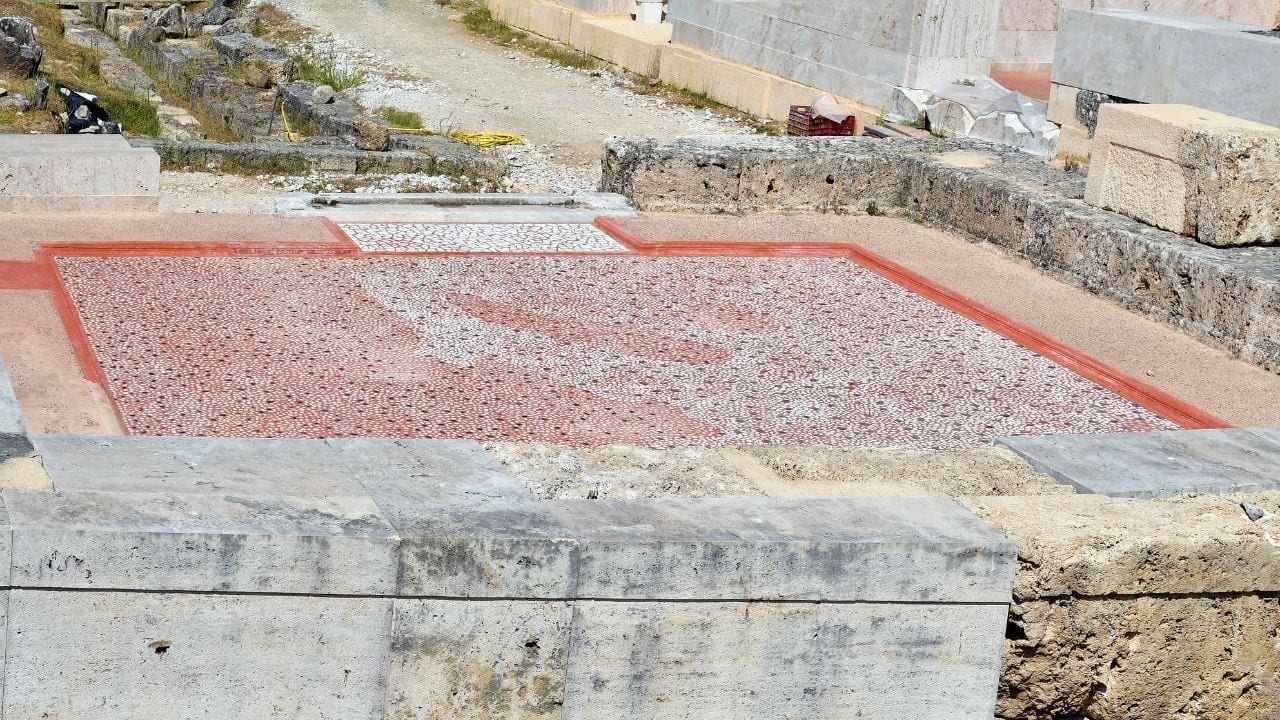
About Vergina in Greece: Vergina was a small, unimportant town until 1977, when several tombs of the kings of Macedon were discovered. One of them belonged to Philip II, the father of Alexander, and was found almost intact.
An impressive archaeological museum was constructed in 1993 to showcase the numerous exhibits. It is one of the most unique museums in Greece, as it was essentially built over the tombs, which have remained in their original place. Certain friezes and frescoes have also survived.
Some of the most important artefacts include exquisite cinerary urns, wreaths and jewellery made of gold, decorated with the Star of Vergina. The bones of Philip II and an unknown woman have also been found.
Close to the Royal tombs, visitors can marvel at the grand Palace of Philip II. In recent years, it has undergone intensive excavation and restoration works, which are ongoing.
The palace, which was built between 359 – 336 BC, was three times the size of Parthenon. The finest materials were used for its construction, to create a marvellous royal residence, truly fit for a king.
Vergina is one of the lesser known Greece landmarks, and about an hour’s drive from Thessaloniki. While you can easily visit independently, a guided tour will help you understand more about the historical background of Greece and Macedonia.
31. Mount Olympus, the home of the Ancient Greek gods
Standing at 2,917 metres, Mount Olympus is the tallest mountain in Greece. This is probably the reason why the twelve mythological Olympian Gods chose to build their residence here.

About Mount Olympus: Olympus was the first landmark site in Greece to be declared a National Park, in 1938. Along with the nearby archaeological site of Dion, they constitute an incredible destination with a long and important history.
Mount Olympus is ideal for everyone, from inexperienced hikers to skilled mountaineers. You can only visit between June and September, as the weather condition outside those months are not favourable.
Some of the easiest routes begin in Litohoro village, and only last a few hours. Some of them may be combined with other activities, such as horse-riding.
As you would expect, there are several challenging routes, including the hike all the way to the top, Mytikas. There are several refuges on the mountain, to accommodate climbers.
People who are serious about reaching the peak of Mt Olympus, might want to have a look at guided tours and see what’s available.
32. The majestic Meteora rocks
If you have seen any photos of Greece, you will definitely remember the gravity-defying monasteries perched on tall, rugged rocks. These are the Meteora monasteries in the Thessaly region, one of the most impressive places in Greece and among the most important landmarks in Europe.
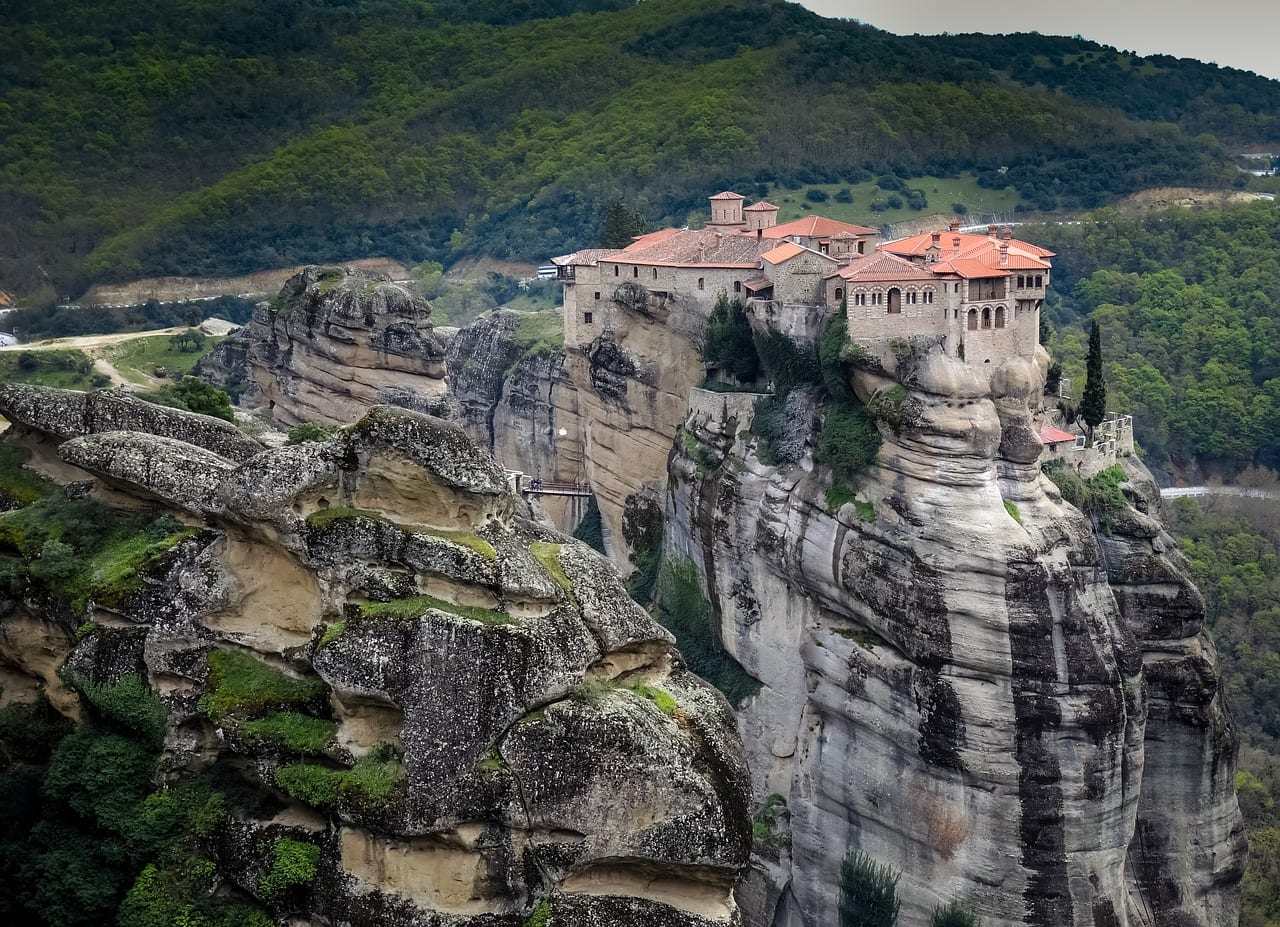
About Meteora in Greece: The first monasteries in Meteora were probably built in the 10th – 11th century AD by monks who wanted to leave the earthly world behind. The area was ideal for that, as the steep rocks made access difficult. The landscape is simply superb, and the seclusion definitely attracted the first people who came to live here.
Gradually, more monasteries were built, though later most of them were abandoned. Today, there are six active monasteries, of which two are nunneries.
Words are not enough to describe the grandiosity of the popular UNESCO site. The combination of unique landscape and centuries-old monasteries make it one of the major landmarks in Greece.
You can get around the Meteora area by car, bus, taxi or on foot. Generally speaking, hiking trails are quite easy, and you will be rewarded with lovely landscapes and beautiful nature.
33. Vikos Gorge in Epirus Region
The huge Vikos gorge, in the mountainous Epirus region, is less famous than other places to visit in Greece. Which means that, if you visit this amazing canyon, you may well end up being on your own!
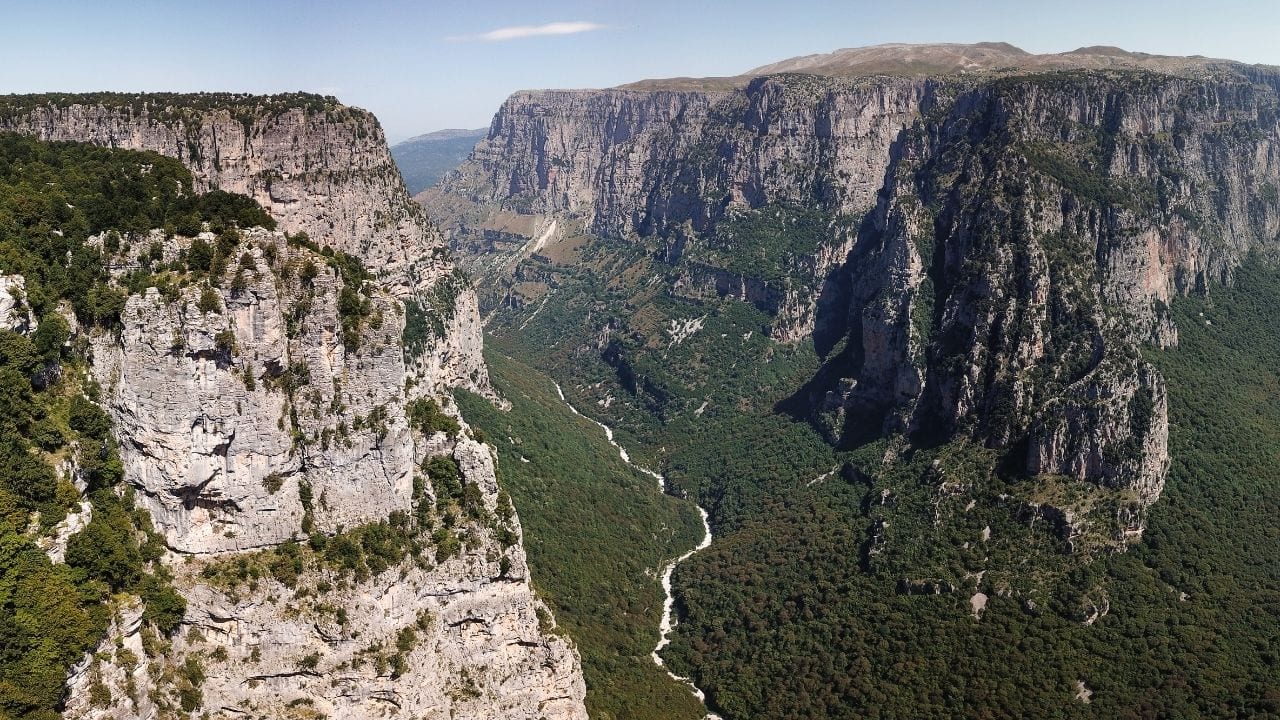
About Vikos Gorge: Some people claim that Vikos gorge is the deepest gorge on the planet, with a depth of over 1,000 metres. According to the Guiness Book of Records, Vikos gorge is the deepest gorge in the world in proportion to its width.
Regardless of which statement is true, Vikos gorge, and in fact the whole of Epirus region, is a well-hidden secret that deserves to be explored. Surely, the fact that it’s a UNESCO Global Geo park must mean something.
Hiking in in Vikos gorge is absolutely amazing. You will see the beautiful Voidomatis river, stone bridges and trees that you never thought existed in Greece! There are several itineraries you can take, depending on your hiking skills and how much time you have.
In addition to the lovely landscape, you can also visit some of the villages in the wider area close to the gorge, known as Zagori. Some of the biggest and most important villages are Papigko, Aristi, Vitsa, Monodendri and Ano Pedina.
Walk around the stone-paved streets and enjoy the traditional architecture. Last but not least, make sure you eat in one of the numerous tavernas, offering delicious local food from the Epirus region.
34. The unique street art all around Greece
You may be surprised to find street art among the most famous landmarks in Greece. Yet, street art is a huge thing here in Greece.

About Street Art in Greece: While for some people street art is strongly related to violence and au underground culture, in Greece it can be a political statement, or simply an expression of creativity.
Several municipalities all around the country have actually commissioned beautiful murals. Even the most devoted anti-graffiti people will agree that they are proper works of art!
One of the most iconic pieces of street art in Greece is this one portraying a stray dog. Known as Loukanikos, the dog joined many of the protesters during demonstrations and riots in the early 2010s. He became a symbol of protest in Greece and beyond, and his photos were even published in Time magazine.
The street art portraying Loukanikos can be found on Riga Palamidou street, one of the tiny alleys in Psyrri area.
Other famous works of street art in Athens include numerous works by Greek artist Sonke, and the world-famous Indonesian artist WD.
Here is some more street art in Athens.
Famous Greece Landmarks FAQ
People planning a trip to Greece, and want to include a visit to a famous landmark or two like the famous Mykonos windmills, Ancient Corinth, or Ancient Agora often ask questions such as:
What are three major landmarks in Greece?
Three of the most important monuments in Greece include the ancient citadel of the Acropolis in Athens, the bronze age remains of Mycenae, and the Epidaurus ancient theatre.
What are two famous landmarks in Greece?
Apart from the obvious archaeological sites, you could also consider the caldera views of Santorini with the whitewashed houses and blue dome churches along with the Unesco World Heritage Site of Meteora as two important Greek landmarks.
Does the temple of Zeus still exist?
The Temple of Olympian Zeus is a major Greek monument still standing in the city of Athens. It is currently undergoing renovation work on the massive pillars that are still standing after 2000 years.
What are the major landforms of ancient Greece?
Various mountains and hills, volcanoes, and numerous islands ran through Ancient Greece's geography. As a result, the ancient Greek city states developed an important sea faring trading culture.
What was the Greeks most famous building?
The Parthenon, which is a Greek temple dedicated to the Goddess Athena is arguably the most single important building that survives today from the Golden Age of Greece.
Famous Greek Landmarks
If you enjoyed this guide to the famous landmarks of Greece, please share it on social media. You can find sharing buttons in the bottom right of your screen.
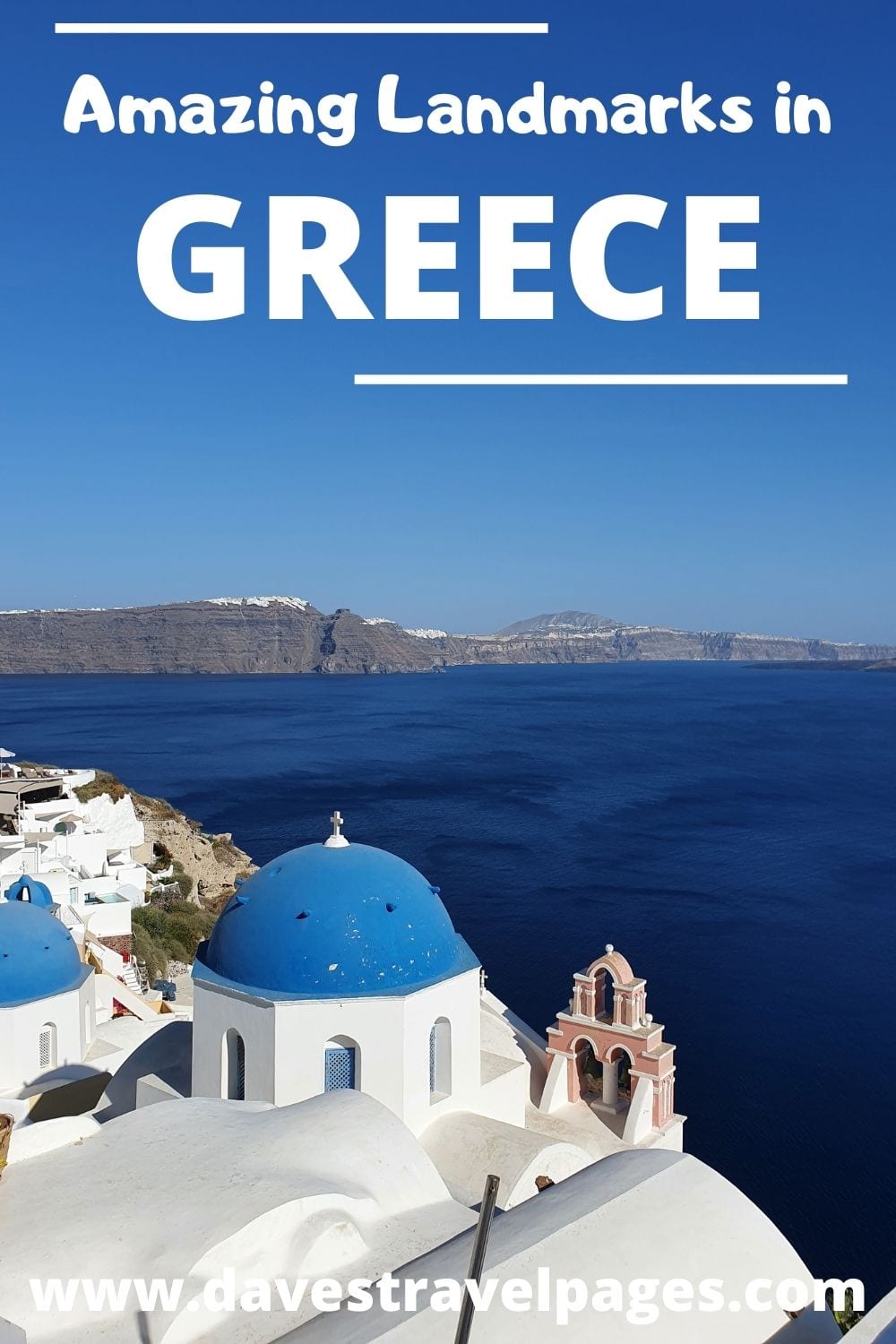
You might also like to read:
- Famous cities of Greece
- UNESCO Sites in Greece
- What is Greece famous for ?
- Interesting facts about Ancient Greece
 – Dave Briggs
– Dave BriggsDave is a travel writer originally from the UK and now living in Athens, Greece. He started this travel blog in 2005, and has written hundreds of travel guides about destinations and landmarks in Greece. He has a somewhat ambitious (perhaps impossible) goal of visiting every Greek island and writing about it.Follow Dave on social media for travel inspiration from Greece and beyond: